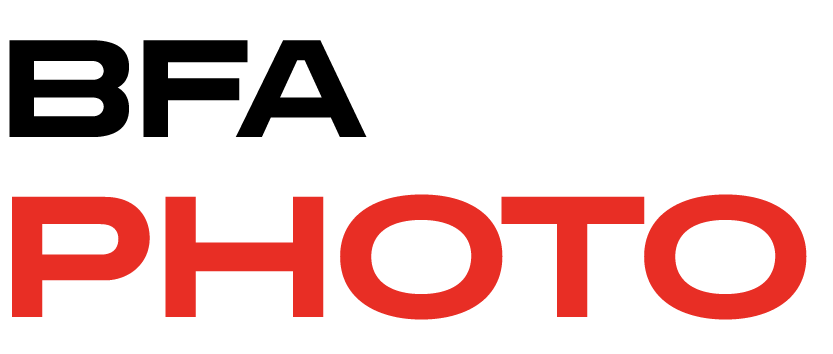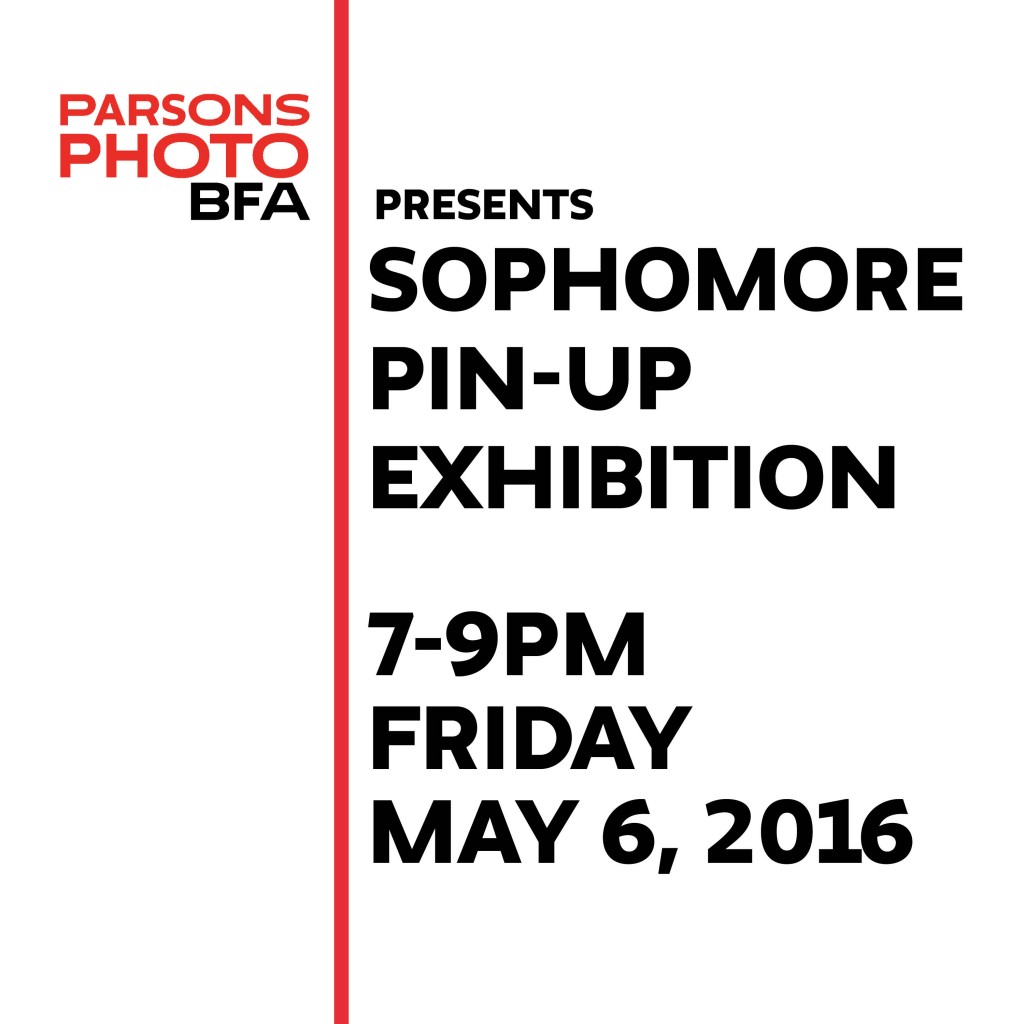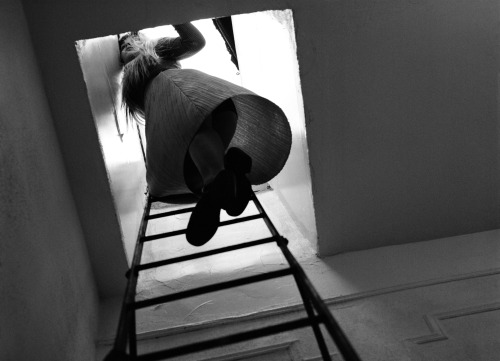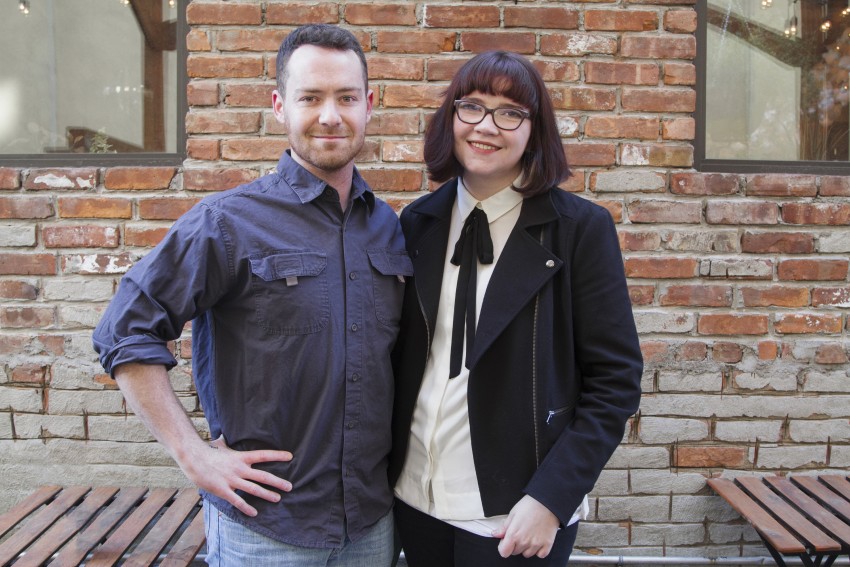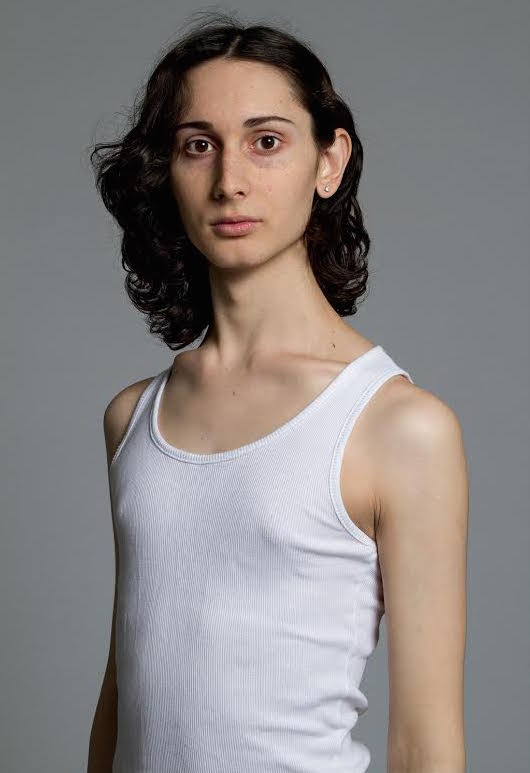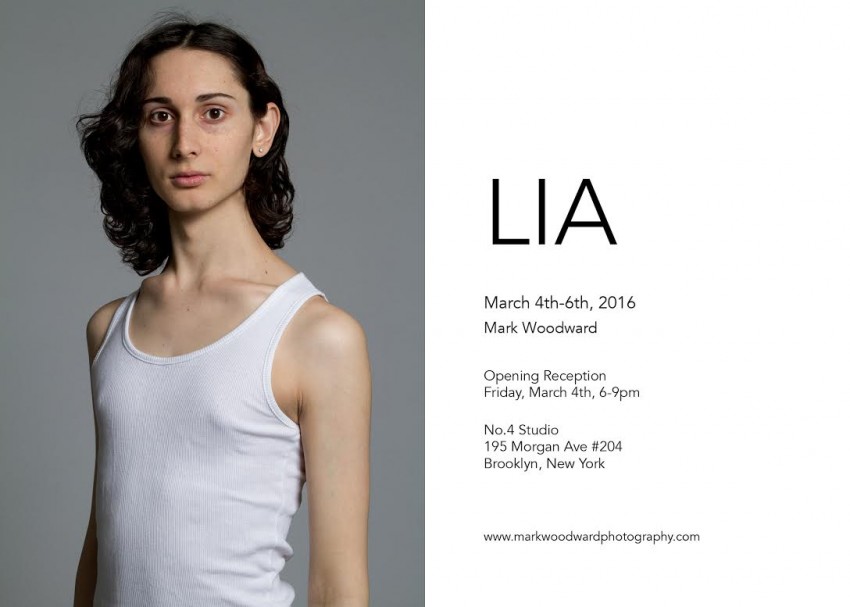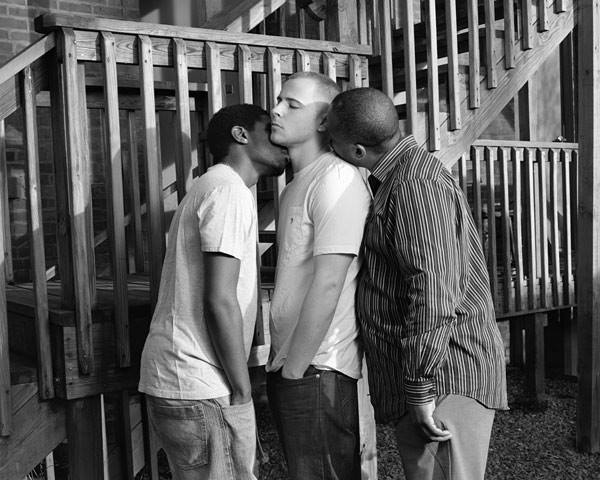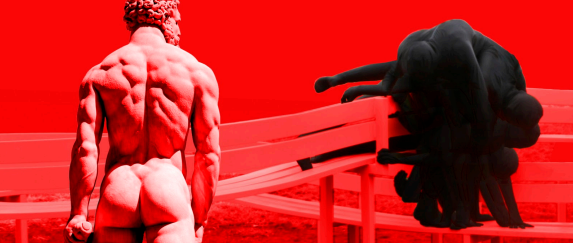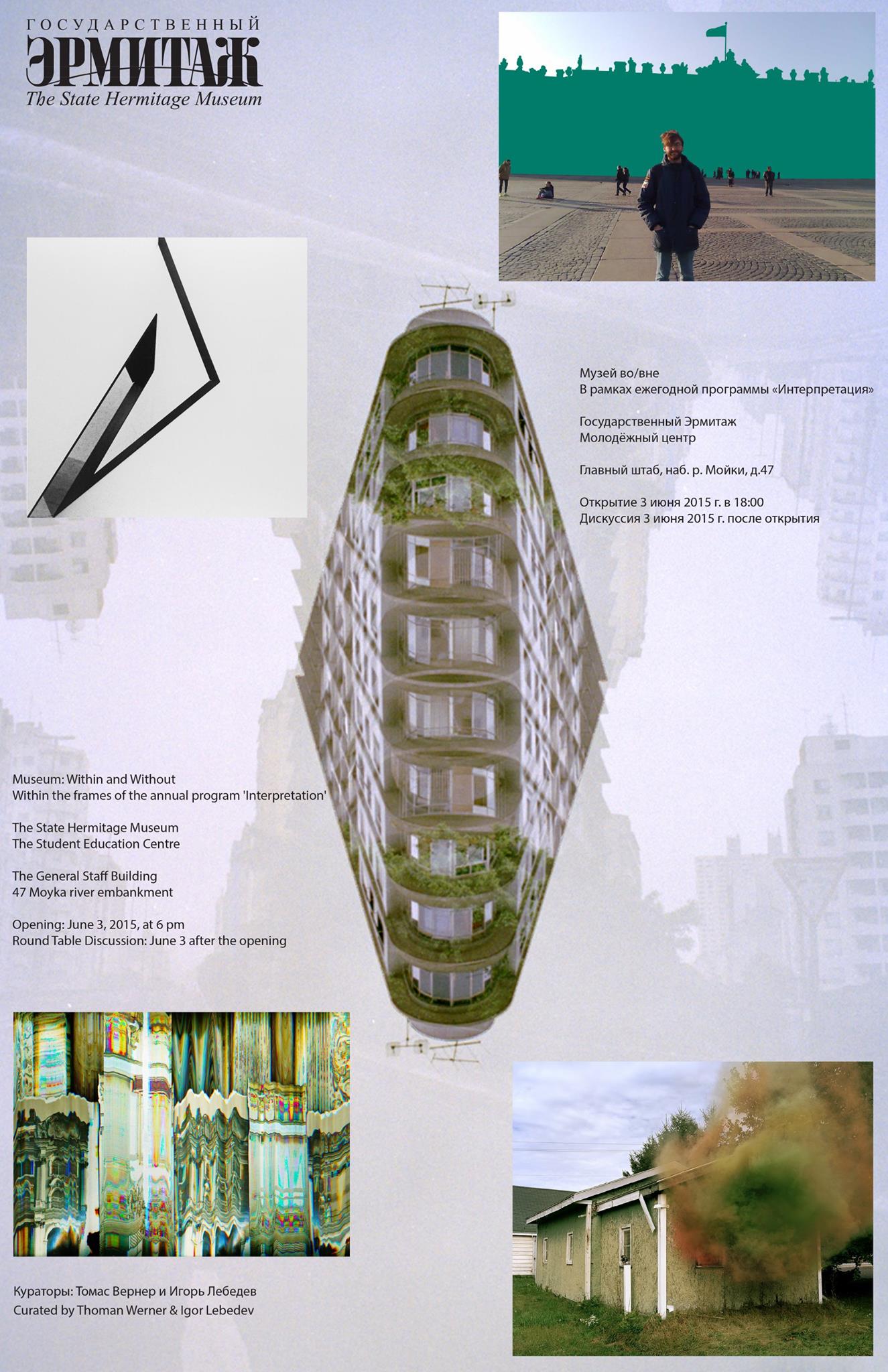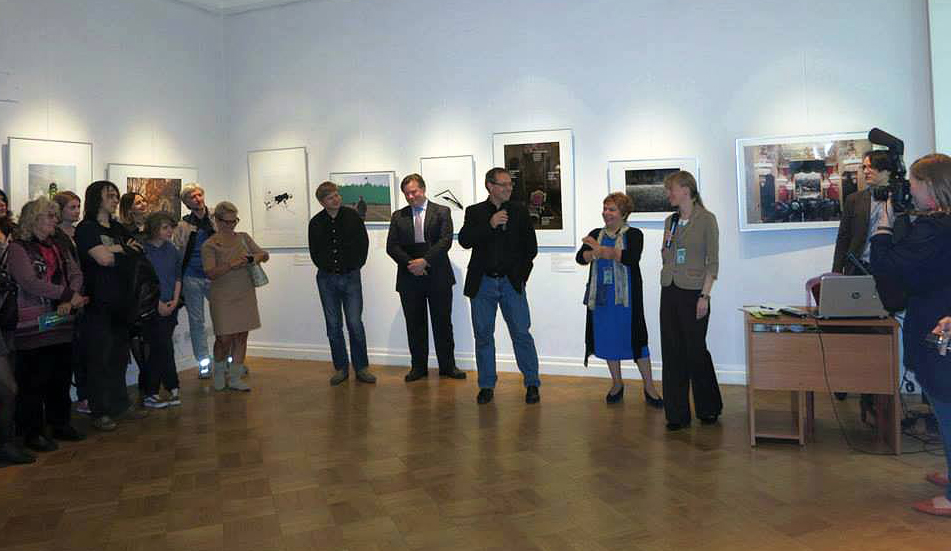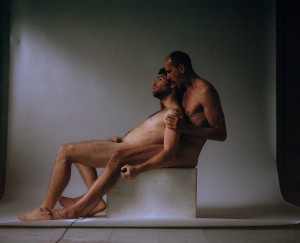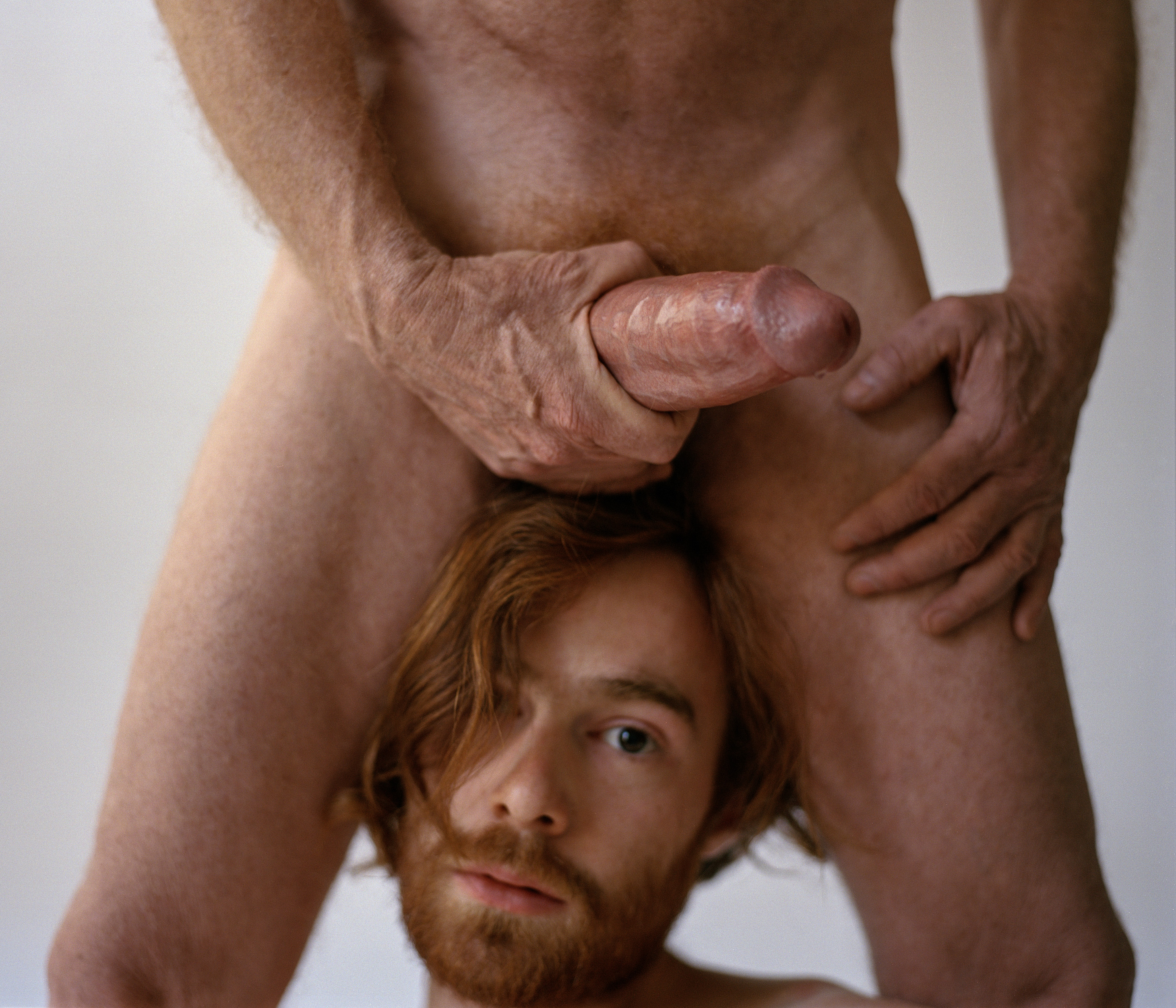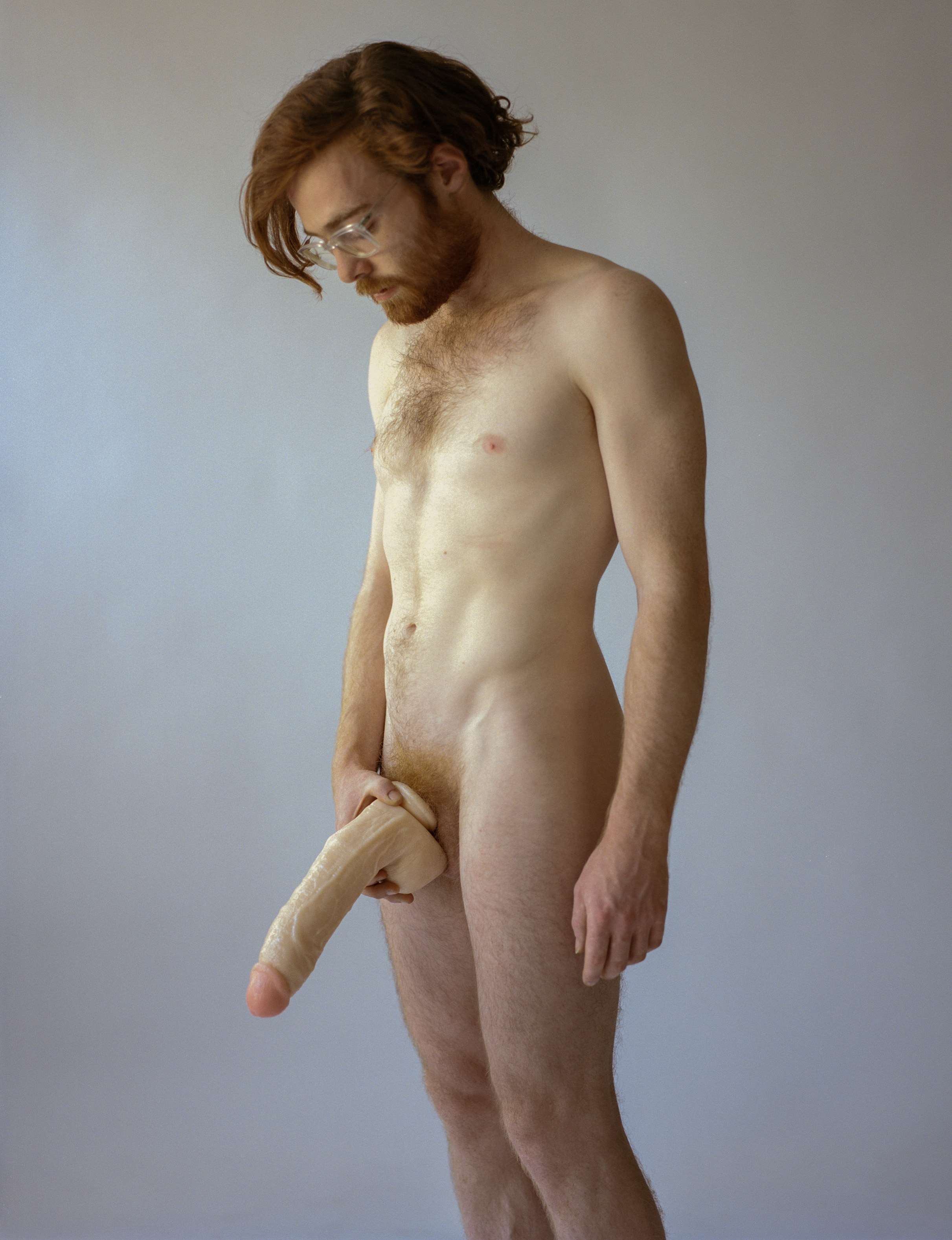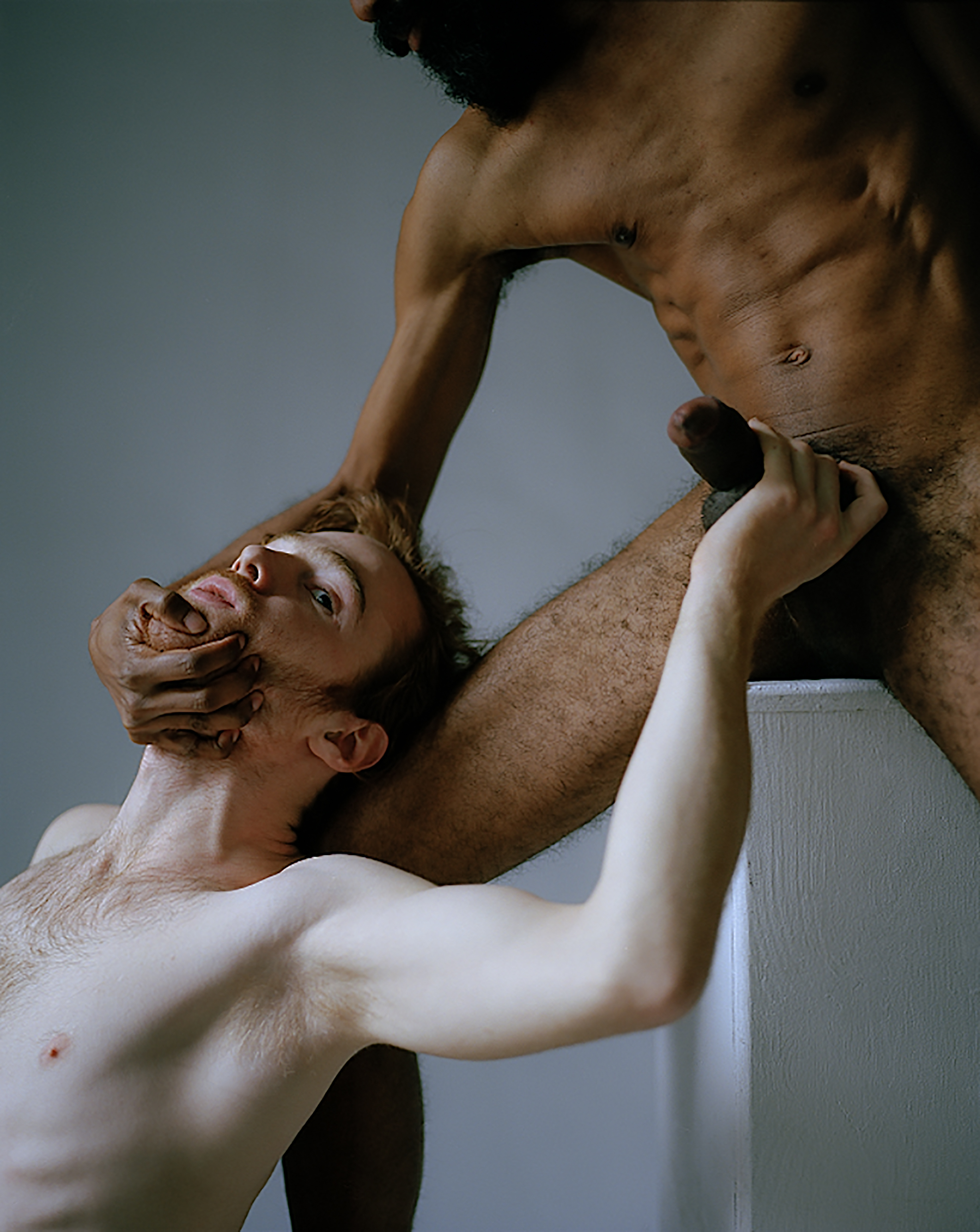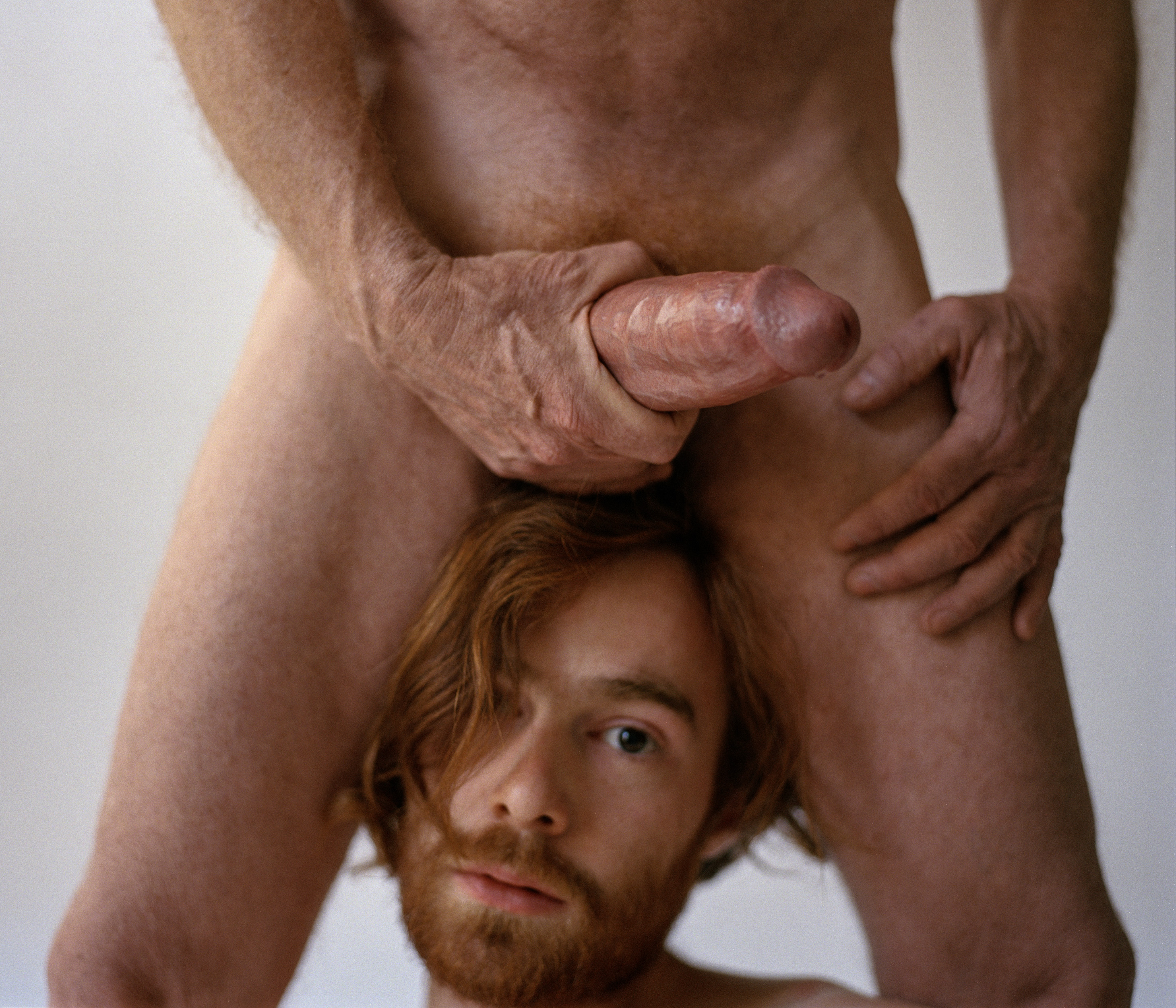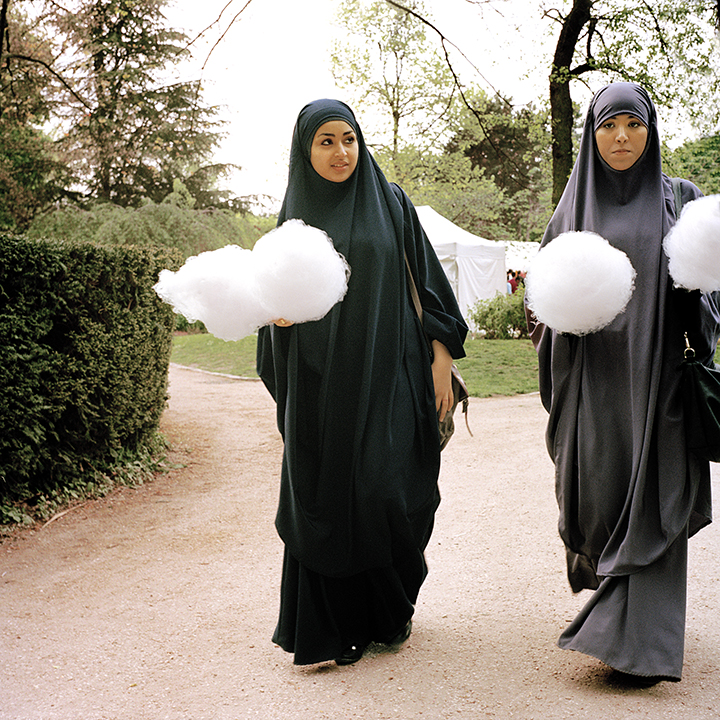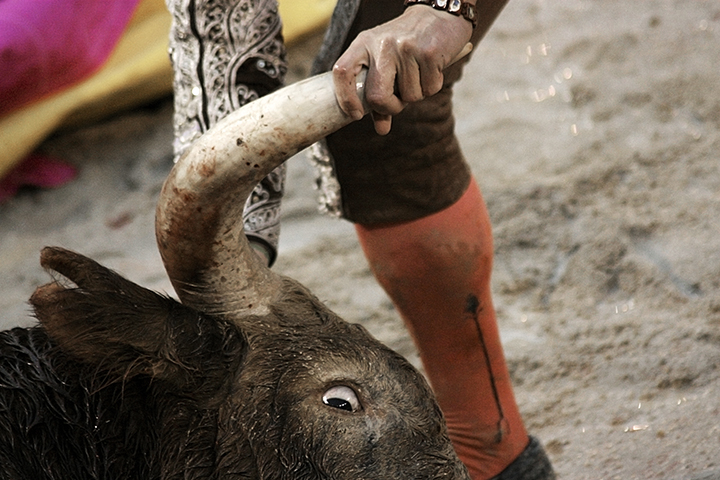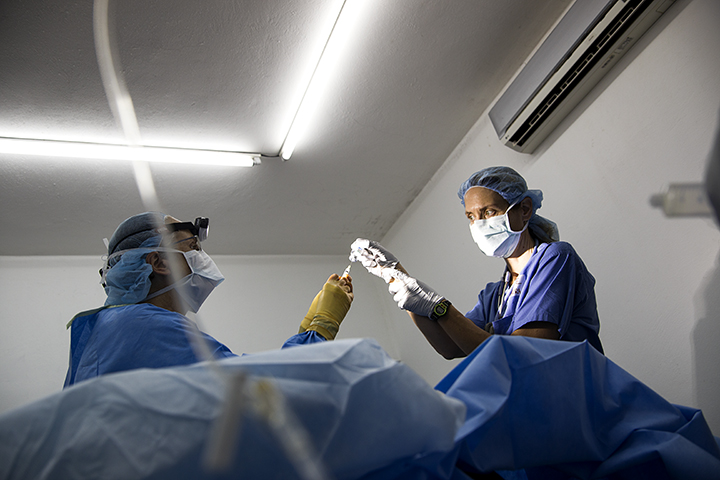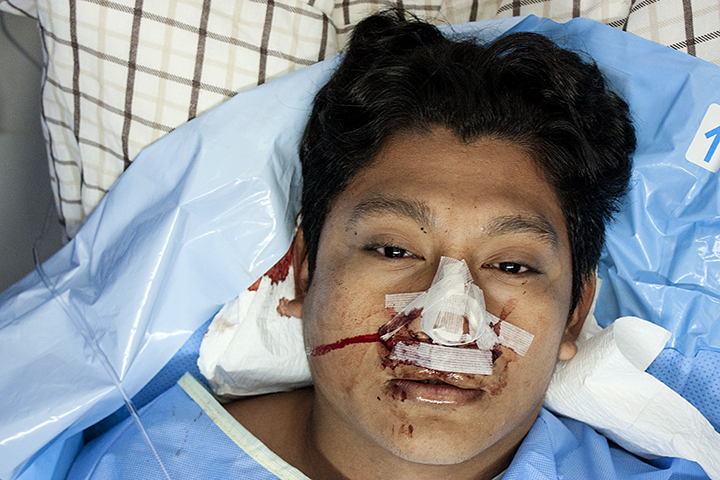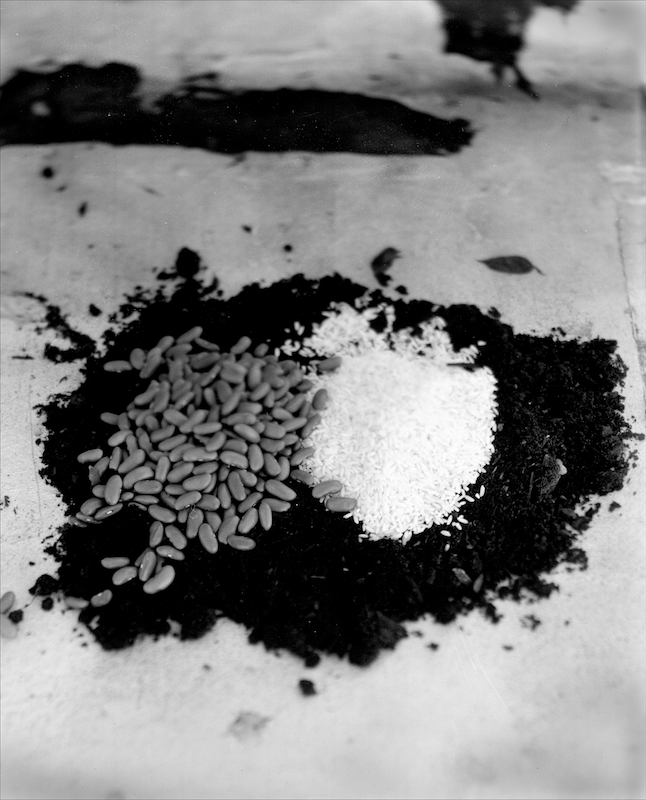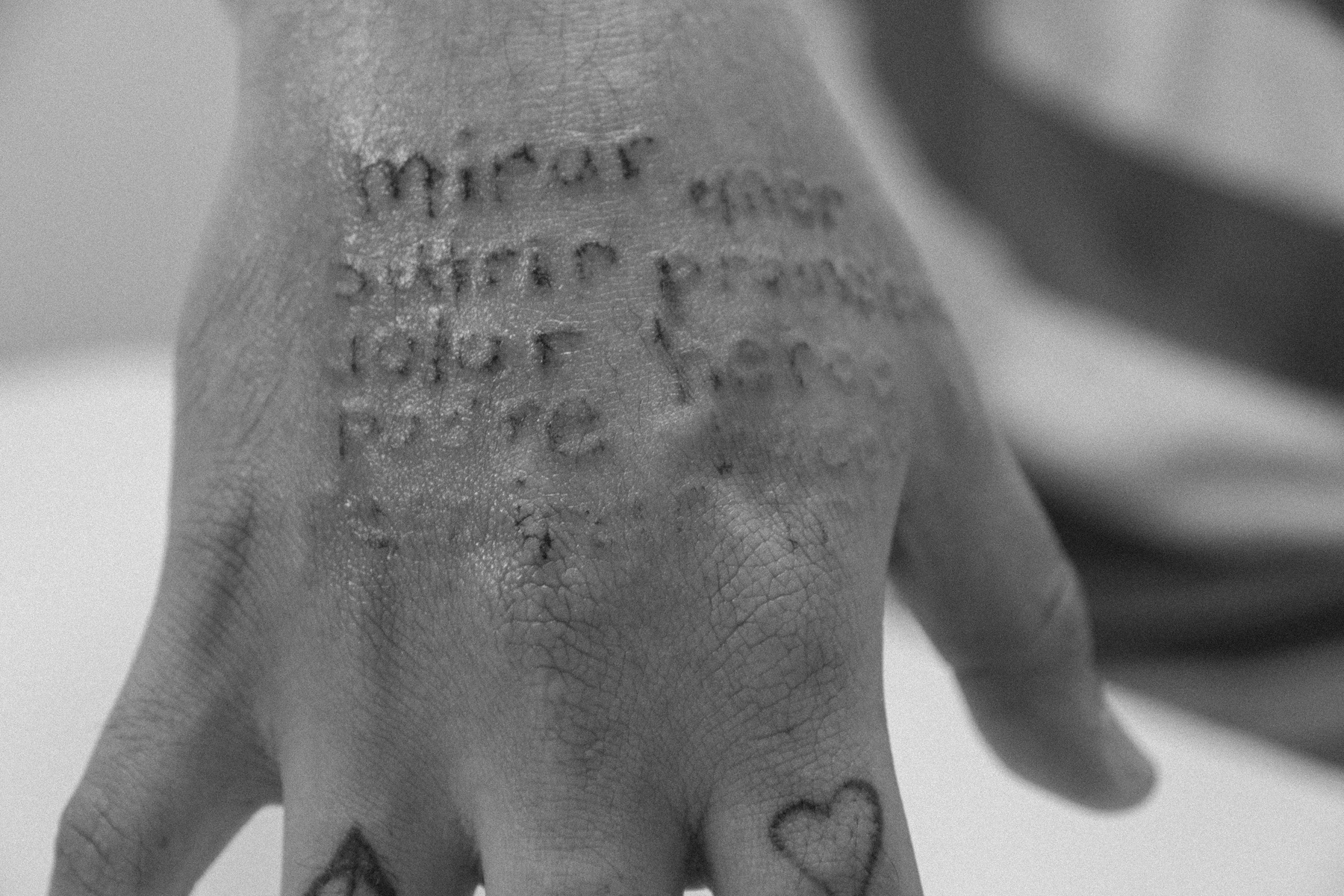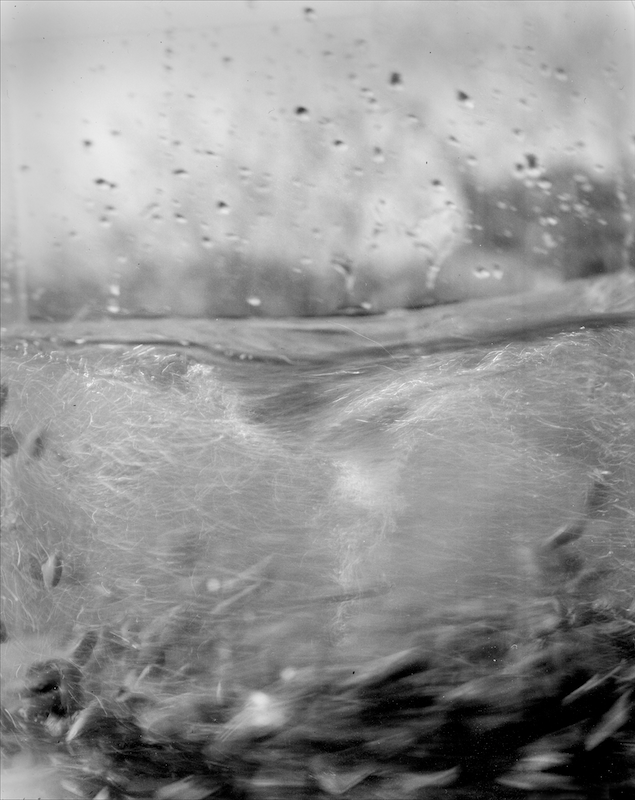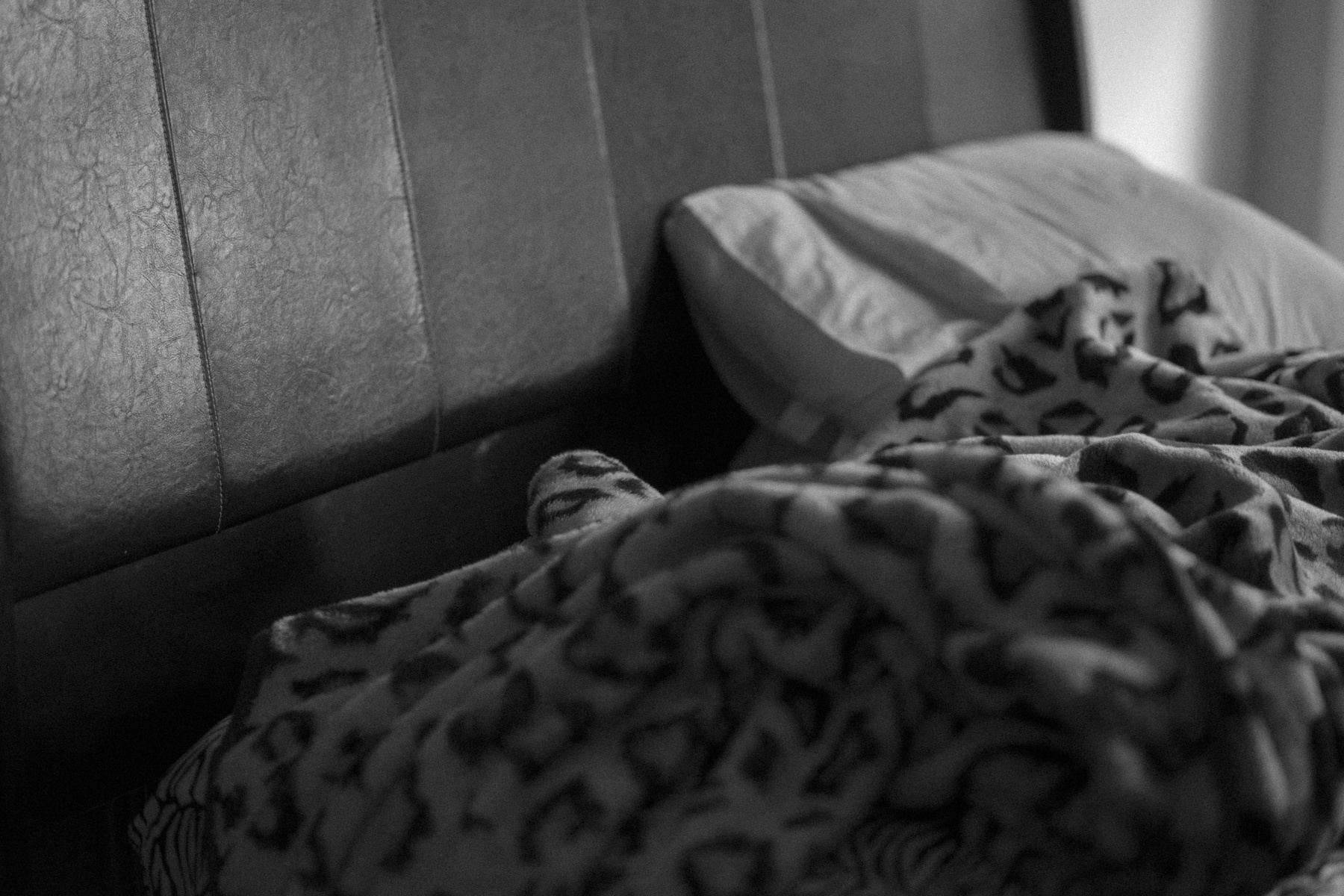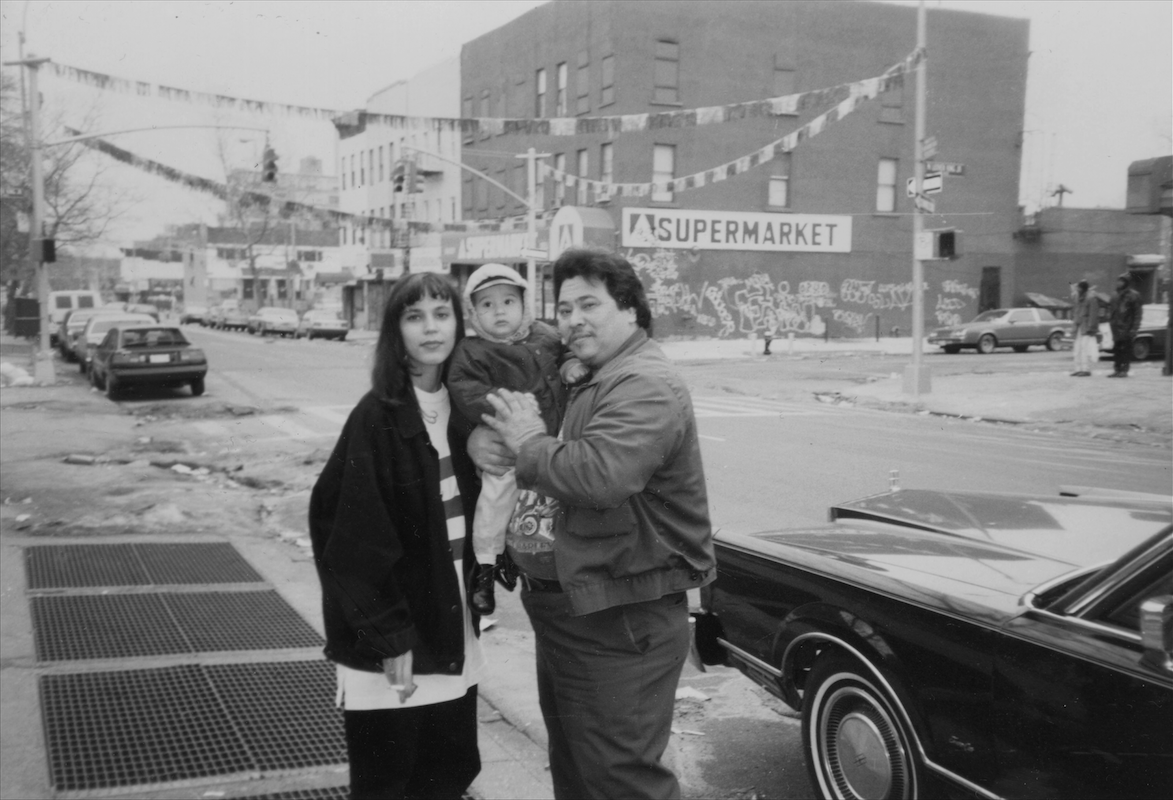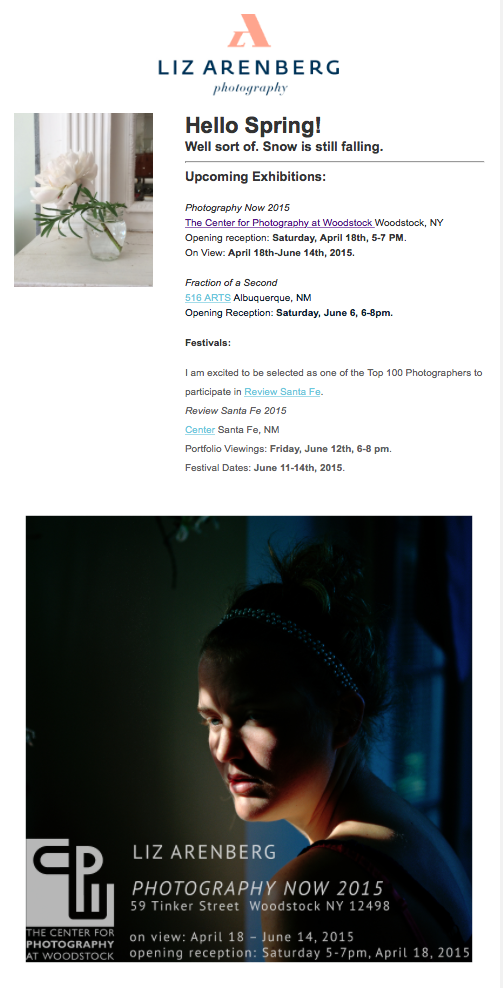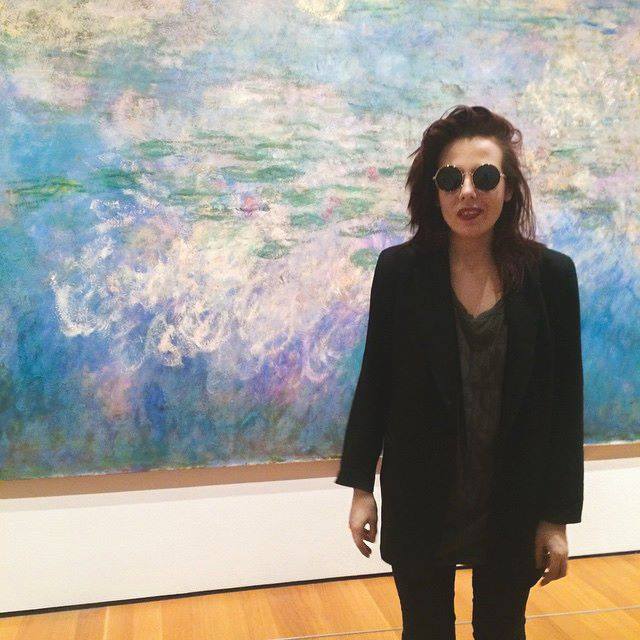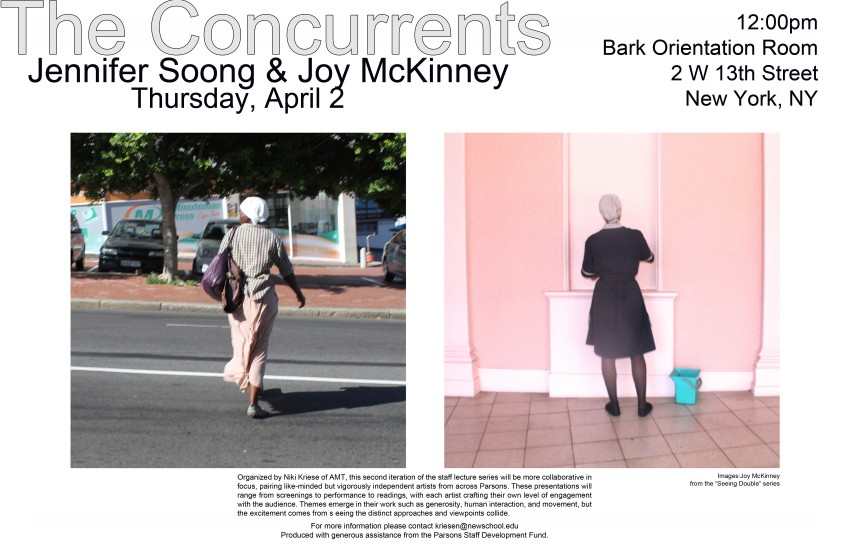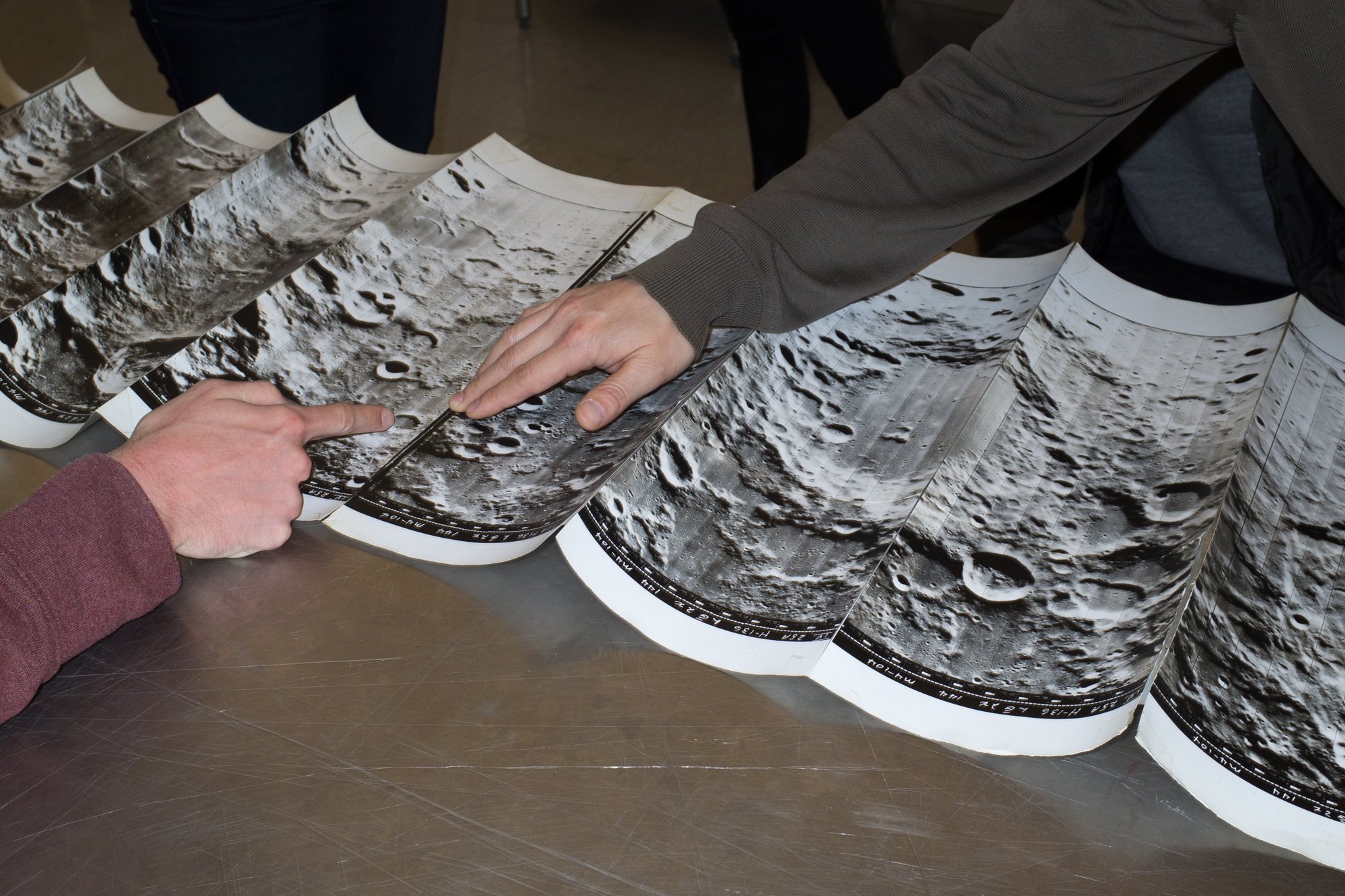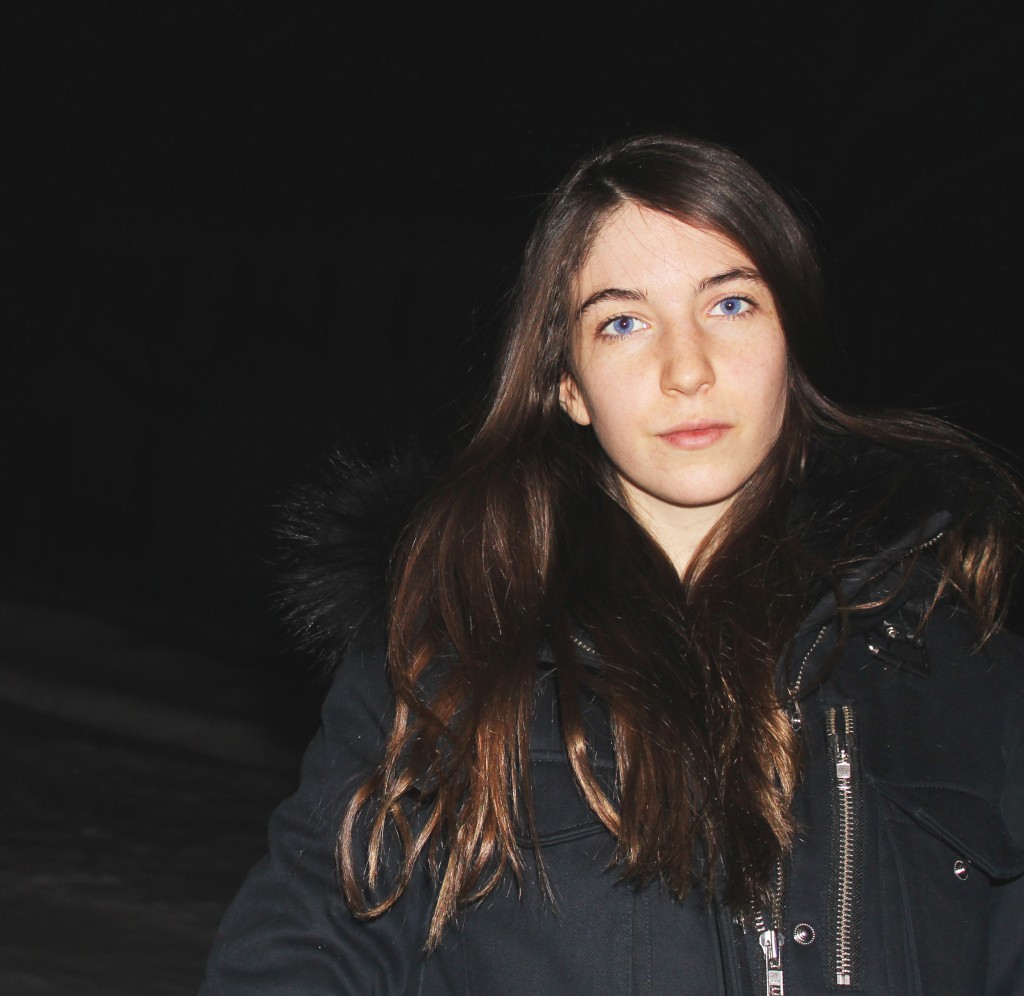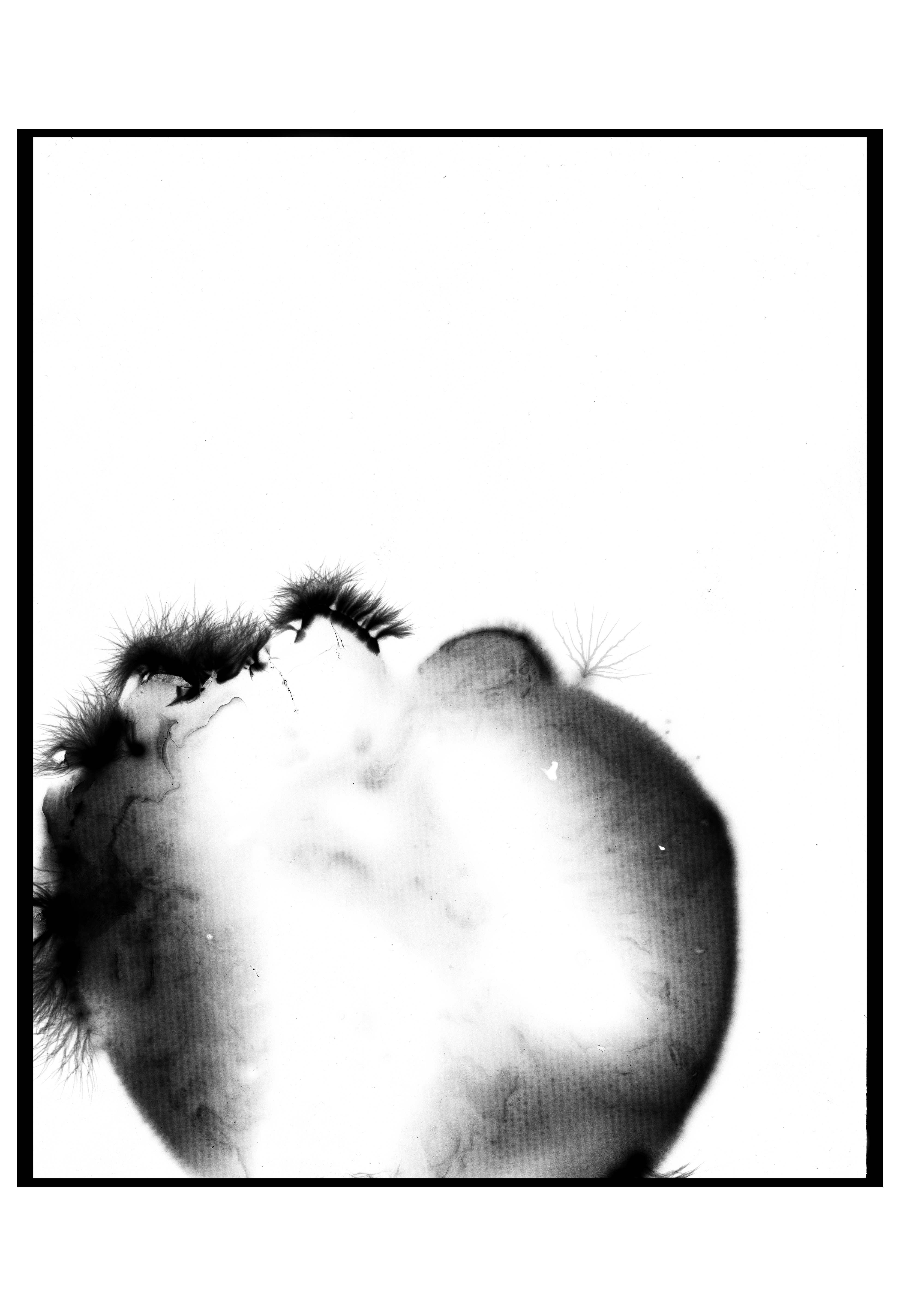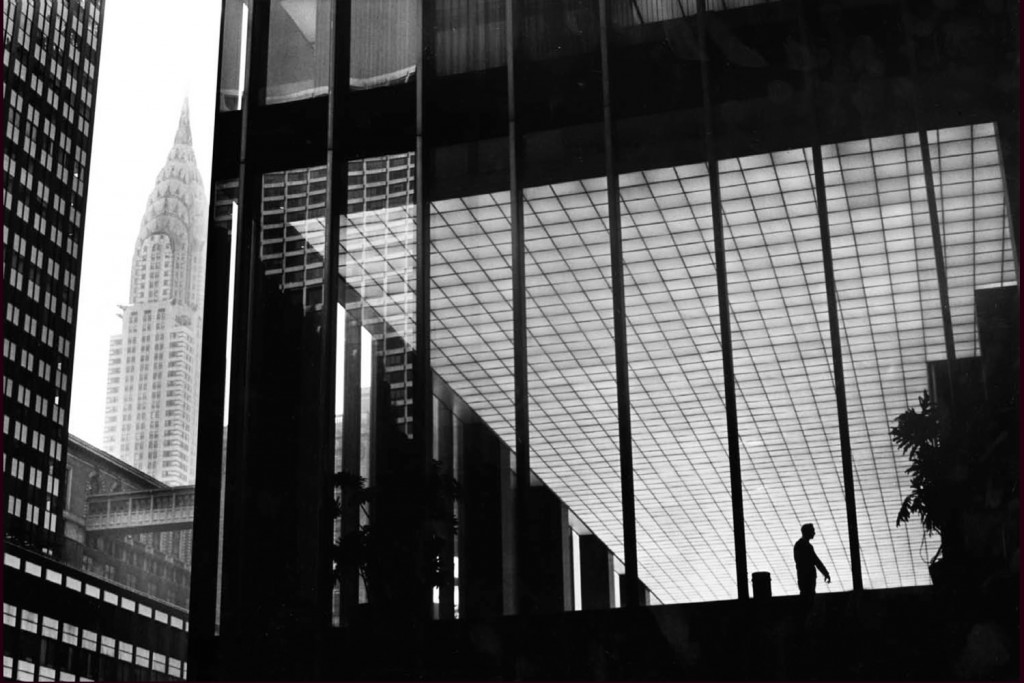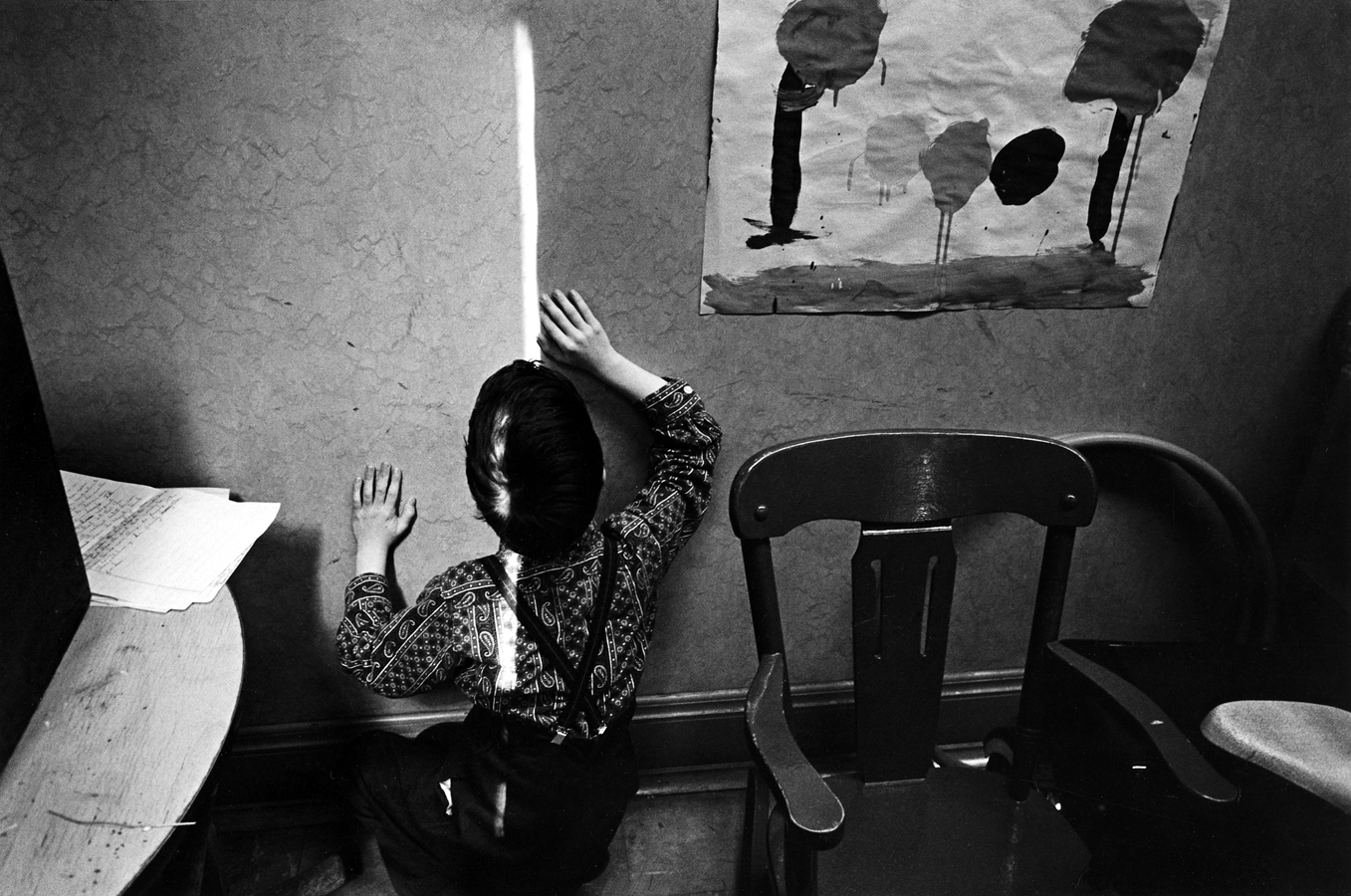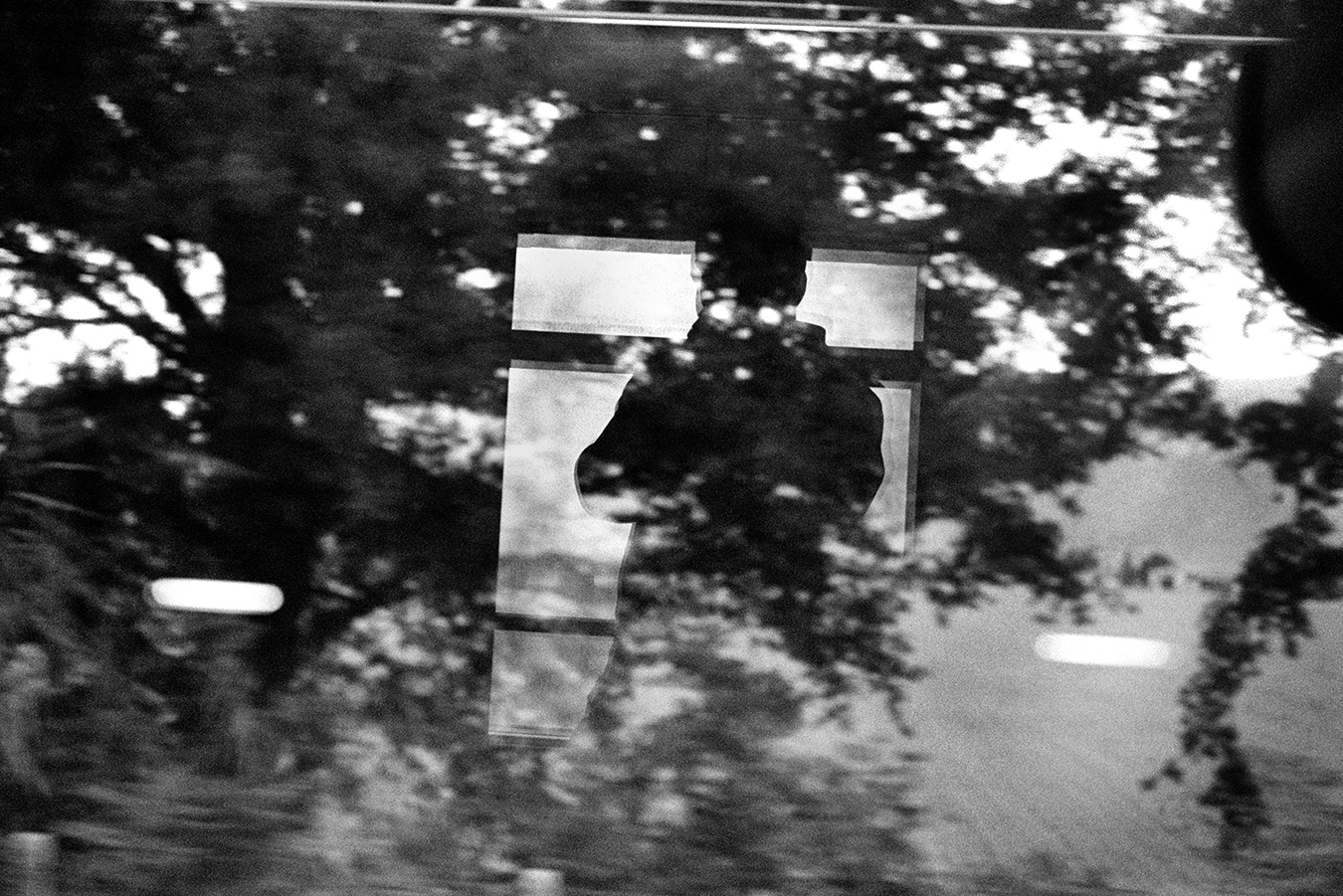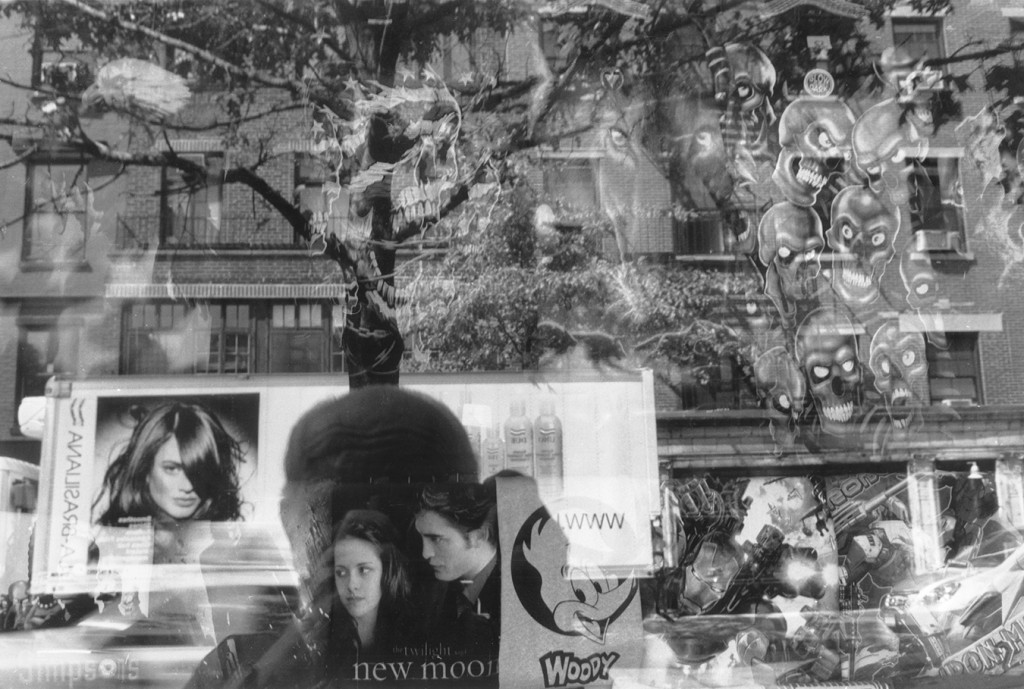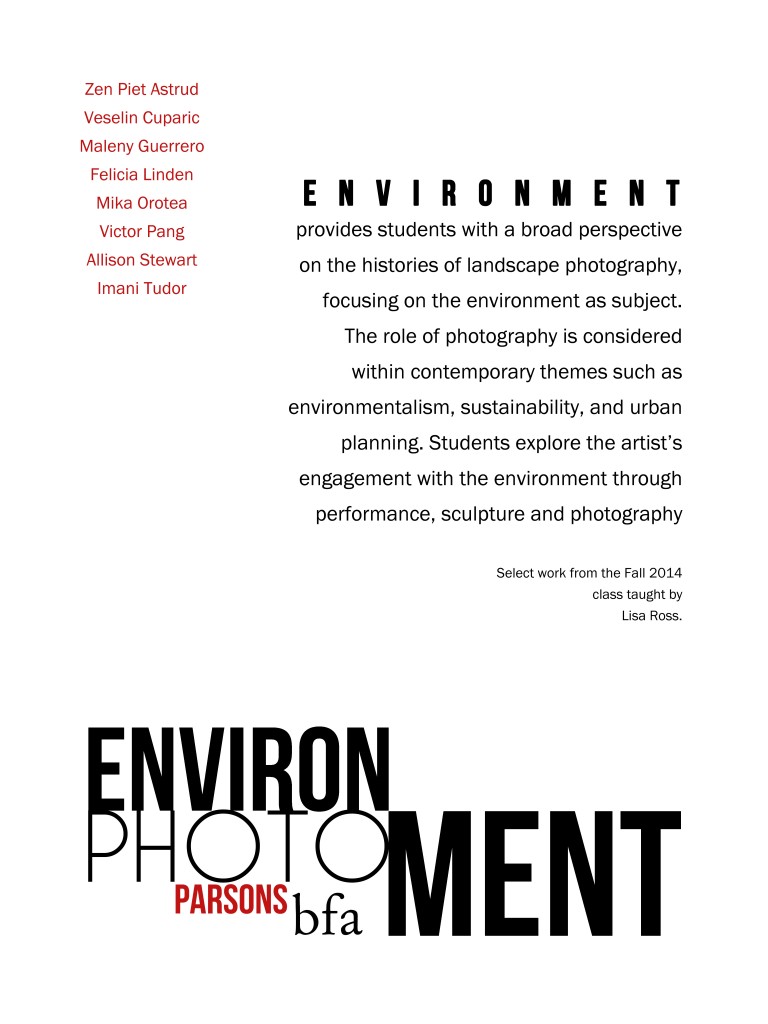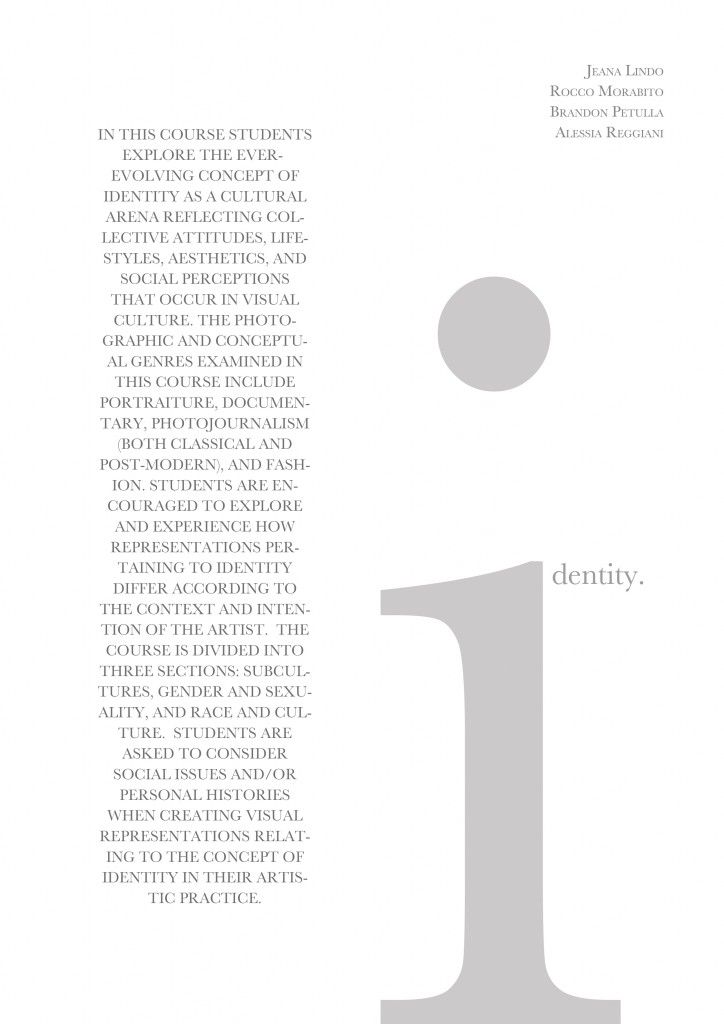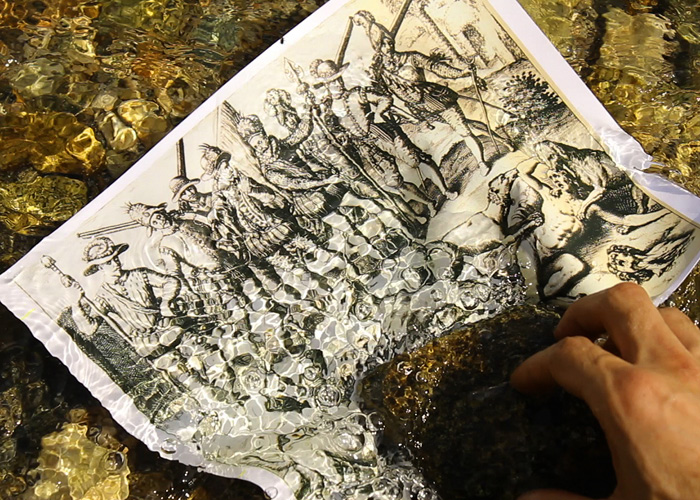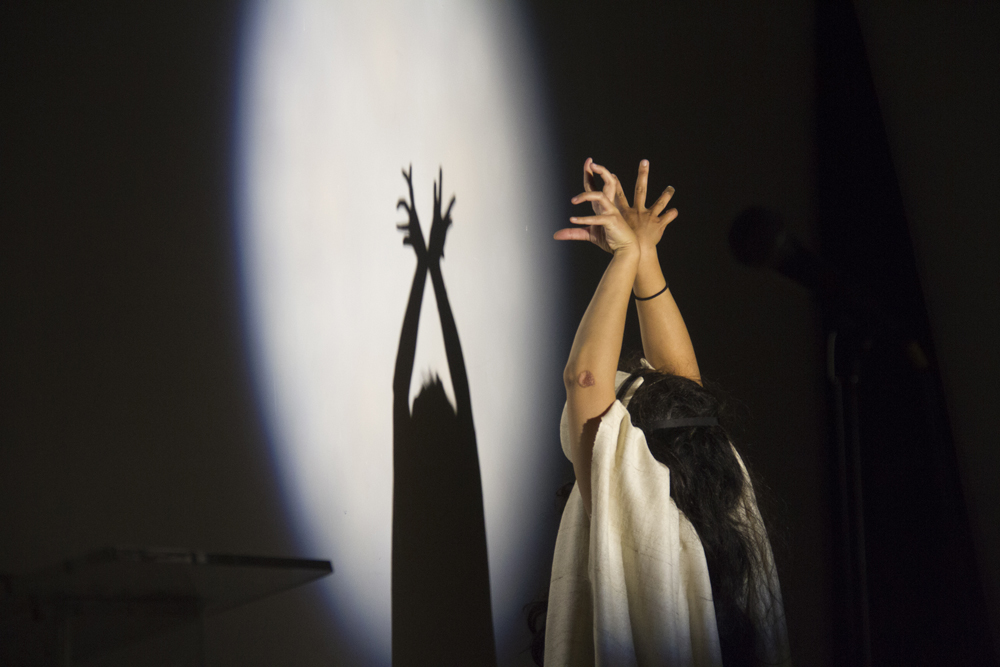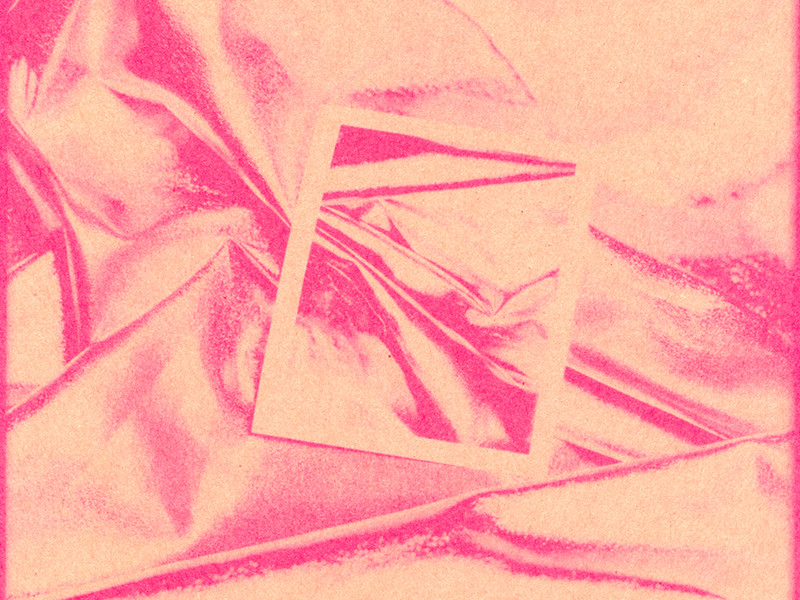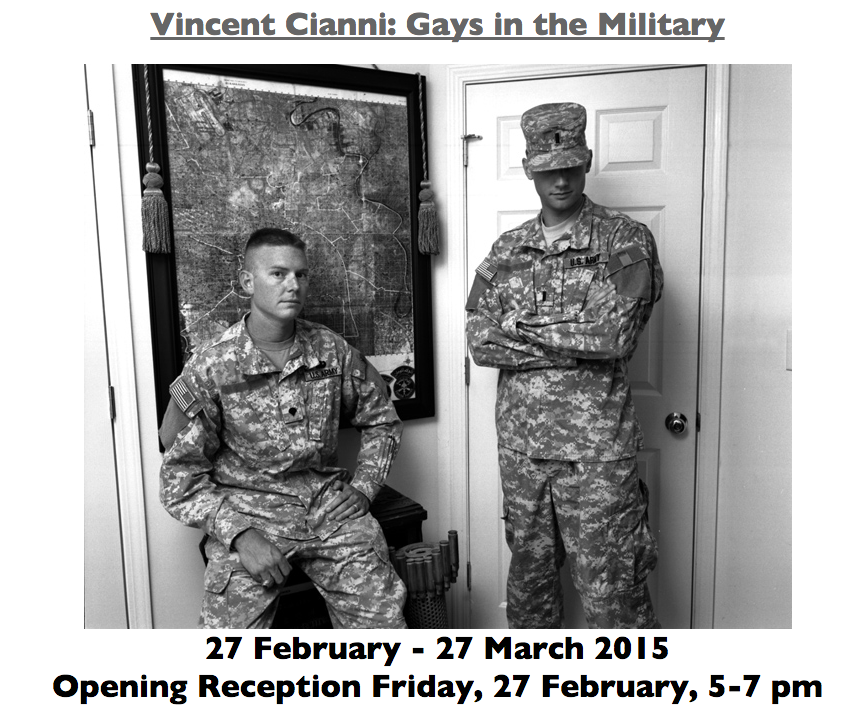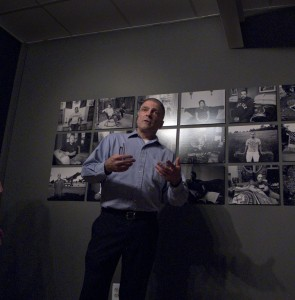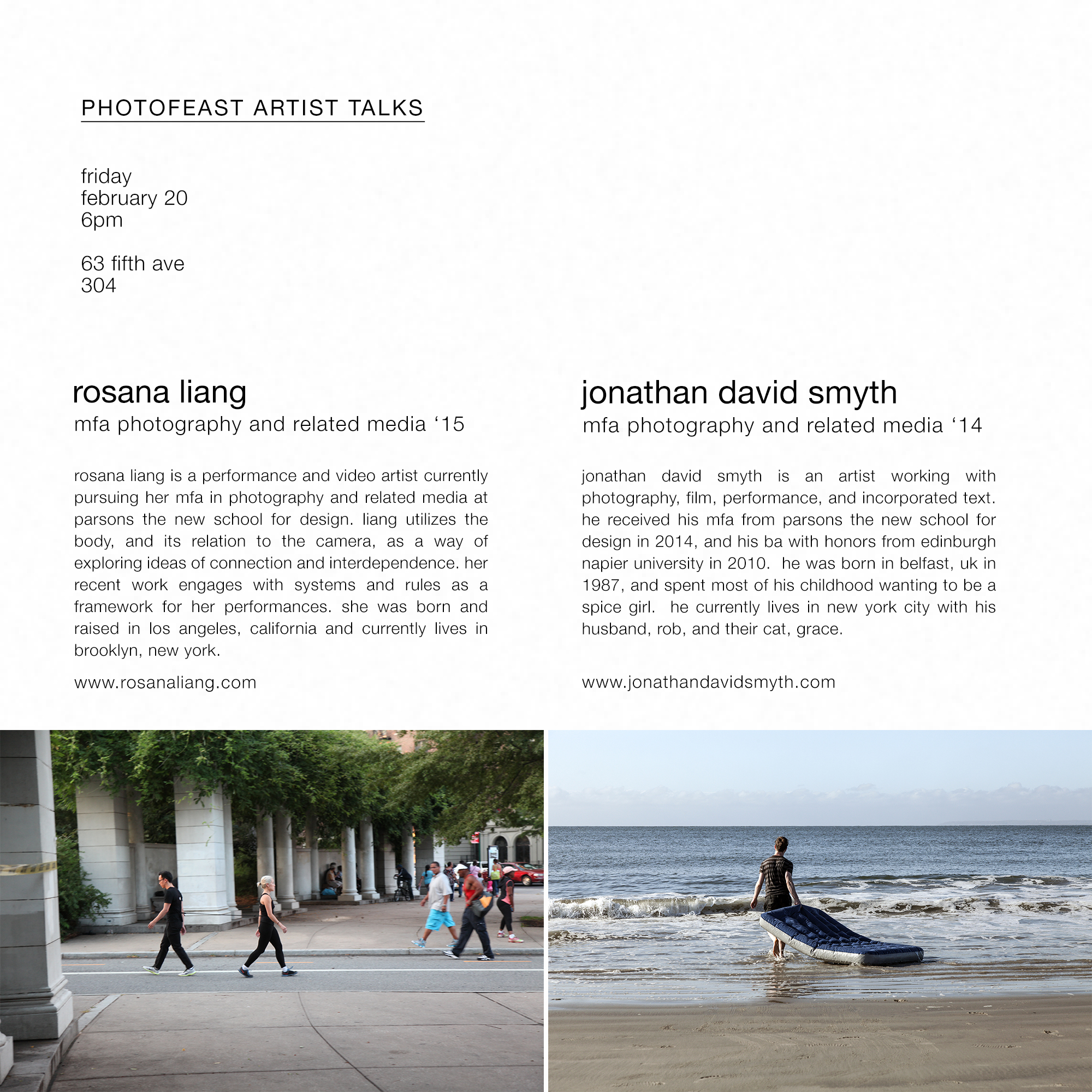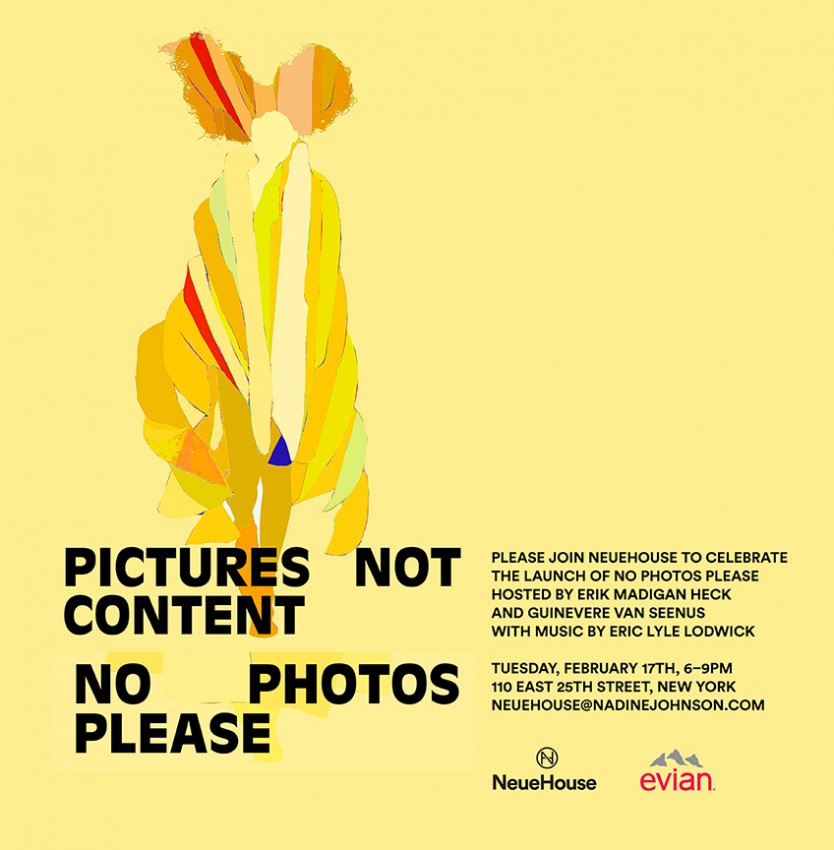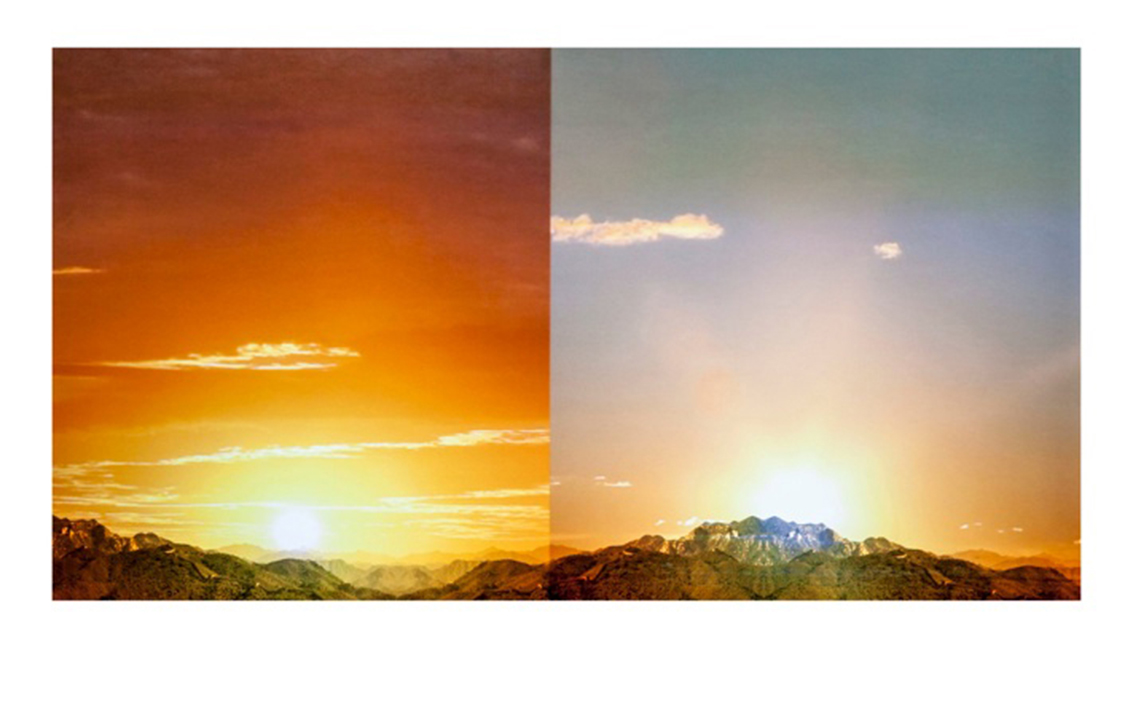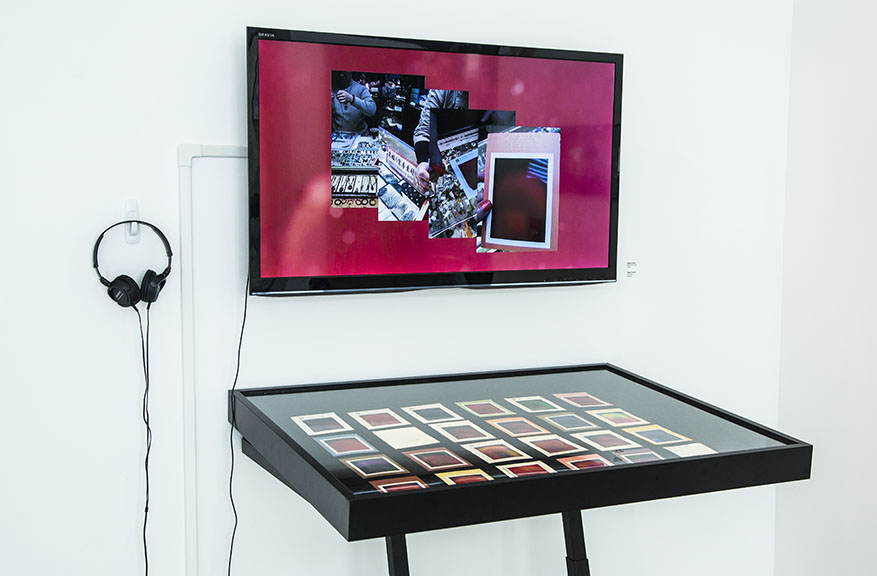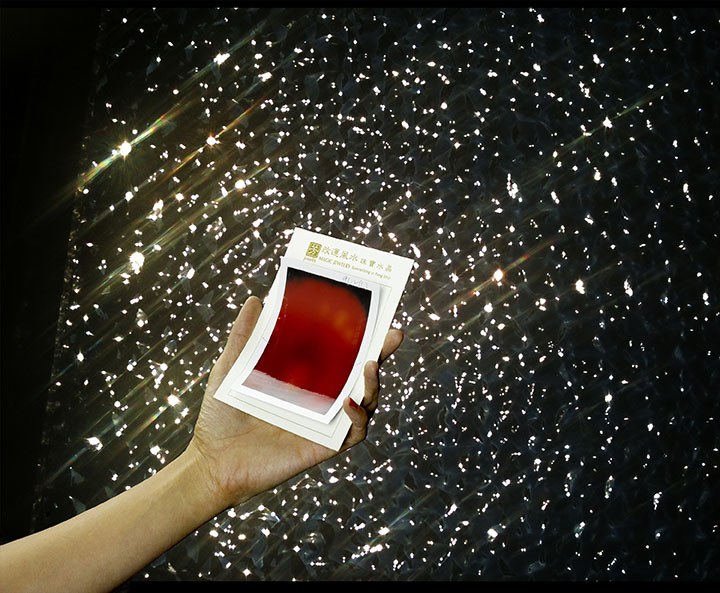News
Megan Paetzhold (BFA Photo ’16) Exhibits at The Aperture Foundation in “Photography is Magic”
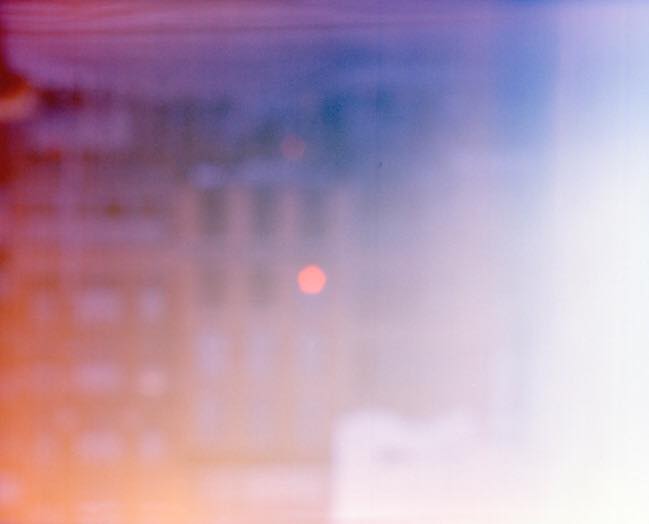
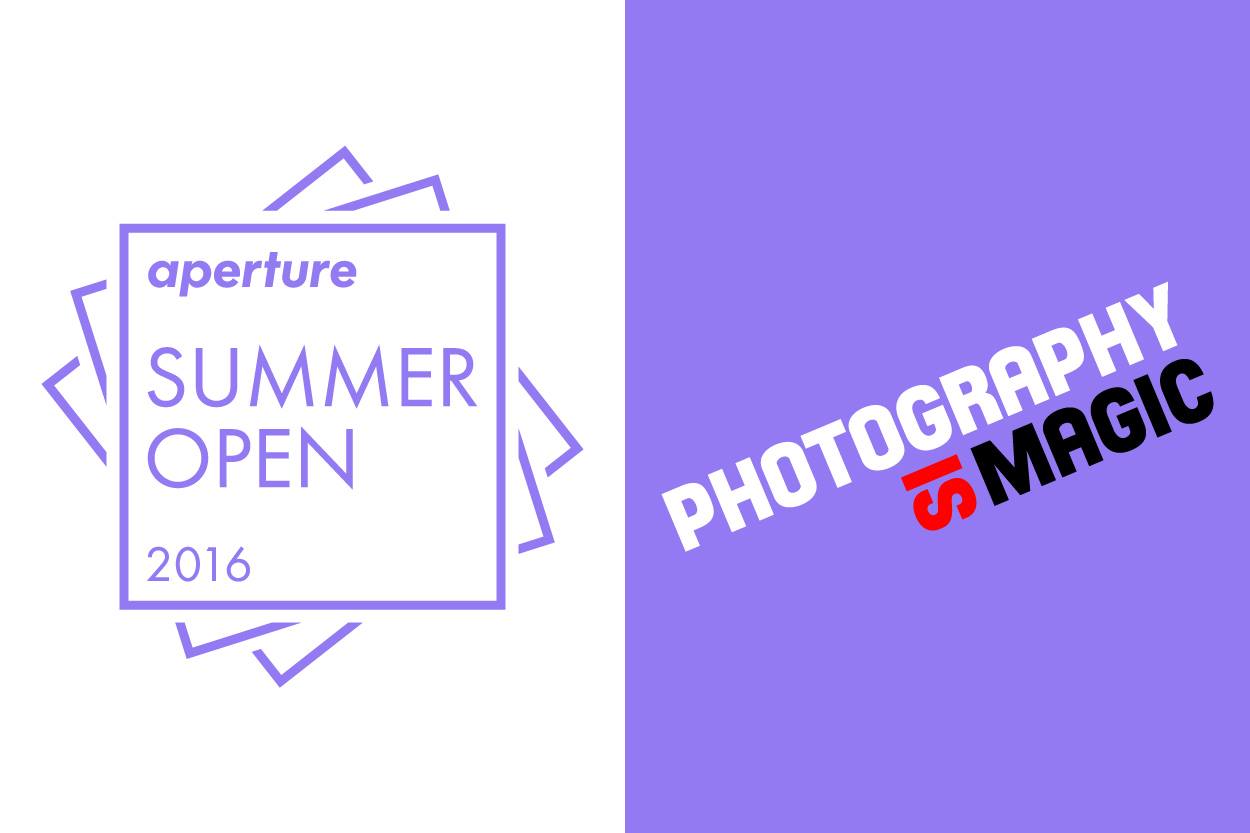
Aperture Summer Open is an annual open-submission exhibition at Aperture Foundation’s gallery that features a wide variety of work drawn from members of our photographic community. Selected annually by a prominent curator or editor, the exhibition seeks to reveal and report on critical themes and trends driving international contemporary photographic practice. The exhibition opens the doors of the Foundation to all photographers, both well- and lesser-known, as it fosters and promotes new ideas and talent.
Paetzhold will be exhibiting work from her series Studies in: Ambylopia
Show Opening:
Thursday July 14th, 6-8pm at the Aperture Foundation
Ryan James Caruthers (BFA Photo ’16) Featured in Huffington Post Arts
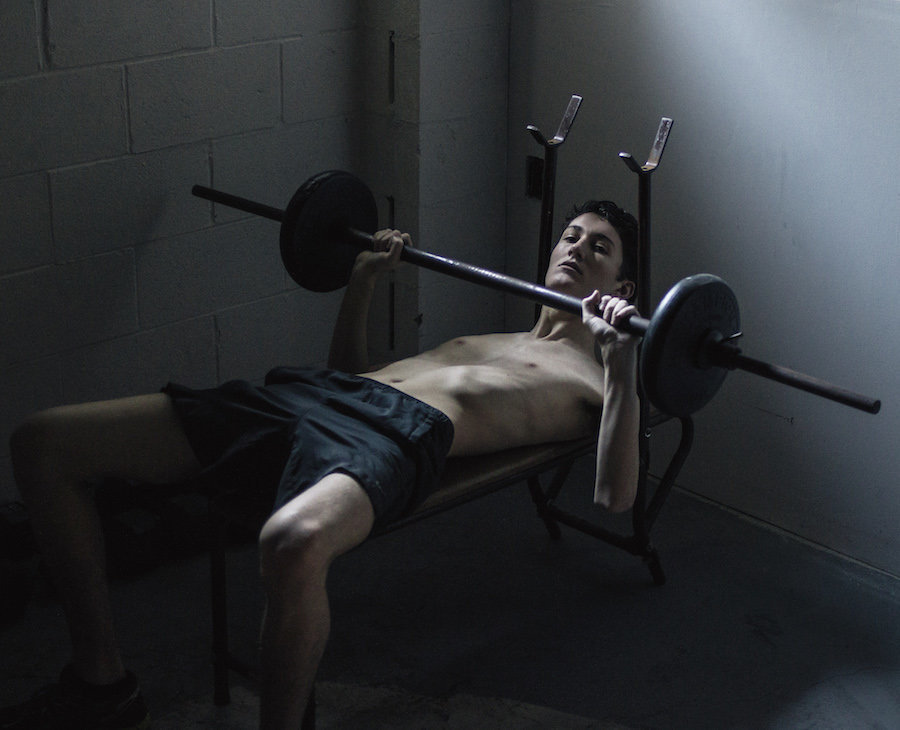
“Photographer Ryan James Caruthers’ self-portrait of himself in a wrestling uniform is a stark departure from that norm. His shape is long and skinny, pale and delicate. His eyes are shut, his arms raised, his face resting somewhere between exhaustion and ecstasy. Blood drips from his nostril like a violent omen. In this striking photograph, Caruthers’ expression resembles that of St. Theresa more than the traditional classical Greek sculptures used to embody athletic masculinity. ”
Queer Photographer Revisits Traumatic High School Sports Tryouts In Stunning Series
Jess Richmond (BFA Photo ’16) Wins Grand Prize in PDN 2016 Edition of The Curator

“The Madness of Many” is a self-portrait series by Jess Richmond depicting her and her imagined twin sister, Connie. Each image is an illusion that is constructed in-camera, toying with spatial relationships, familial relationships and the picture plane.
BFA Photography Sophomore Pin-Up Exhibition
Join us on Friday, May 6th for our BFA Photography Sophomore Pin-Up Exhibition.
66 5th Ave, 3rd floor. 7-9pm
Facebook event page:
https://www.facebook.com/events/1784678878427589/
Adrian Lam, BFA Photo Alumni, Helps Launch New High End Lifestyle Site, RealClearLife
RealClearLife is a guide to a life well lived. As the men’s lifestyle affiliate of RealClearPolitics, RealClearLife curates and creates the world’s most striking images and ideas, commissions top new content, and keeps our audience connected to the best of the world around them.
Visit RealClearLife for more information.
Photo Faculty Matthew Jensen Named Guggenheim Fellow
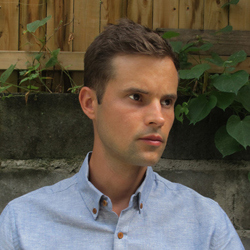
Matthew Jensen, Part-Time Lecturer at Parsons, has been named as Guggenheim Fellow in Photography for 2016. Jensen has taught in the Photography program at Parsons since 2012.
The Guggenheim Foundation’s announcement gives a comprehensive history of Jensen’s work and background:
Artist Matthew Jensen’s multi-disciplinary practice combines walking, collecting and rigorous site-specific explorations of landscapes. His projects strive to connect people to places by expanding the traditions of landscape photography to include a range of mediums and actions. Each body of work develops from time spent in publicly accessible landscapes or by examining the way different technologies transform this experience.
Walking and participation have been central to a number of Jensen’s recent projects. Walking Flatbush, is an artist-map and poster created and distributed in conjunction with Crossing Brooklyn at the Brooklyn Museum (2014). A Walker’s Guide to Chadds Ford, also an artist-map and poster, was the centerpiece of Jensen’s solo exhibition at the Brandywine River Museum of Art in Chadds Ford, Pennsylvania (2014). Both maps combine found objects, native plants, historical research, and anecdotes with logistical information. Jensen combined community participation, walking, history, and collecting in his exhibition The Wilmington Center for the Study of Local Landscape at the Delaware Center for the Contemporary Arts (2013). The final installation provided an outlet for the work created by participants and also featured discoveries made by Jensen throughout the Wilmington park system. One series of photographs titled, Tree Love, documented the tree carvings and arborglyphs found in abundance along the Brandywine River. The age-old tradition was revealed to be a century-old subculture with thousands of carvings hiding off-trail on nearly every beech tree; a marriage proposal, poems, vulgarities, insults, countless hearts, and portraits dating as far back as 1903. Jensen designed and led artist walks in conjunction with the aforementioned exhibitions as well as for Storm King Art Center, the Municipal Arts Society, City as Living Laboratory, Lower Manhattan Cultural Council, Third Streaming and Elastic City.
New York City landscapes have been the subject of many of Jensen’s photographic and collection-based projects. The ongoing project Park Artifactshas been presented in various iterations in solo exhibitions on Governors Island (2010), at Wave Hill (2012), at the Queens Museum during his ArtBuilt Mobile Studio residency (2015), and in Brooklyn Bridge Park (2016). The collection contains over 6,000 artifacts found in plain sight during walks through parks. Historical objects like a Spanish Real from 1746, flint arrowheads, clay pipes, and trading beads mix together with objects as familiar as fishing lures and plastic toys. Ian Frazier, writing for the New Yorker, described the wandering process in an article titled Lost and Found (23 July 2012).
Light and landscape combine as metaphor in numerous works by Jensen. In 2009 the Metropolitan Museum of Art acquired his photographic seriesThe 49 States and exhibited it in After Photoshop: Manipulated Photography in the Digital Age (2012). The photographs were derived from months of exploring small towns in the early days of Google Streetview. The series is also in the collection of the National Gallery of Art where it was also exhibited (2016). Other works like The Sun Returning, 14 Hour Sunset and Rainbow Around the Sun were exhibited together at Yancey Richardson Gallery as part of Jensen’s solo show Feels Like Real (2015).
Matthew Jensen received his B.A. in political science and fine arts from Rice University in 2002. He worked on a number of national, state, and city grassroots political campaigns prior to receiving his M.F.A from the University of Connecticut in photography and sculpture in 2008. He is a MacDowell Fellow and has participated in residencies at the Queens Museum, Lower Manhattan Cultural Council, Wave Hill and Kimmel Harding Nelson Center for the Arts. Jensen has been a part-time lecturer of photography and studio art at Parsons/The New School since 2012. He has also taught at SUNY Purchase, George Washington University and the University of Connecticut.
Parsons Alumni and Faculty to Exhibit in Queens International Exhibition

Sylvia Hardy (MFA Photography ’12), Magali Duzant (MFA Photography ’14) and Shadi Harouni (Faculty in Fine Arts) Exhibiting in Queens International 2016, the Queens Museum’s biannual exhibition of artists living or working in Queens, NY. The show highlights and contextualizes the artistic vibrancy of the borough through cultural productions in all media. The seventh iteration looks to the idea of thresholds and the way spaces for transition, contact, and exchange operate. These notions of borders and acts of border-crossing are also characterized by collaborations with Trans-Pecos, an alternative music venue, and Ayham Ghraowi, designer and creative director for the exhibition’s multi-outlet publishing platform.
The Opening Reception is taking place on April 10, 4PM – 8PM
Queens International 2016 is organized by guest curator Lindsey Berfond and Queens Museum Director of Exhibitions Hitomi Iwasaki.
Participants
Manal Abu-Shaheen
Vahap Avşar
Jesus Benavente and Felipe Castelblanco
Brian Caverly
Kerry Downey
Magali Duzant
Golnaz Esmaili
Mohammed Fayaz
Kate Gilmore
Jonah Groeneboer
Bang Geul Han and Minna Pöllänen
Dave Hardy
Sylvia Hardy
Shadi Harouni
Janks Archive
Robin Kang
Kristin Lucas
Carl Marin
Eileen Maxson
Melanie McLain
Shane Mecklenburger
Lawrence Mesich
Freya Powell
Xiaoshi Vivian Vivian Qin
Alan Ruiz
Samita Sinha and Brian Chase
Barb Smith
Monika Sziladi
Alina Tenser
Trans-Pecos (with 8 Ball Community, ESP TV, and Chillin Island)
Mark Tribe
Sam Vernon
Max Warsh
Jennifer Williams
Kambui Olujimi (BFA Photo ’02) Exhibits Solastalgia at CUE Art Foundation

Curated by Hank Willis Thomas
CUE Art Foundation
137 W 25th St, New York, NY 10001
Opening: April 7, 2016, 6-8 PM
On view from April 7-May 12
Kambui Olujimi presents the opening of Solastalgia at the CUE Art Foundation. The exhibition includes large-scale sculptures, silkscreens, and paintings. The works in the show reside at the intersection of numerous issues of current concern to me: the condition of New York City and the nation including gentrification, police killings (both by and of the police), as well as the challenges of commemoration and loss.
The term solastalgia was coined by Australian philosopher Glenn Albrecht in 2003. Essentially it is the feeling of homesickness when one is still home. “Solastalgia is when your endemic sense of place is being violated,” Albrecht describes. Though the term originally references the psychological displacement of farmers due to climate change, I use it as a lens to examine the psychological dynamics tied to the rapidly changing five boroughs.
BFA Photo Faculty and Program Director Colin Stearns’ Book “Meridian” Reviewed in Photo Eye
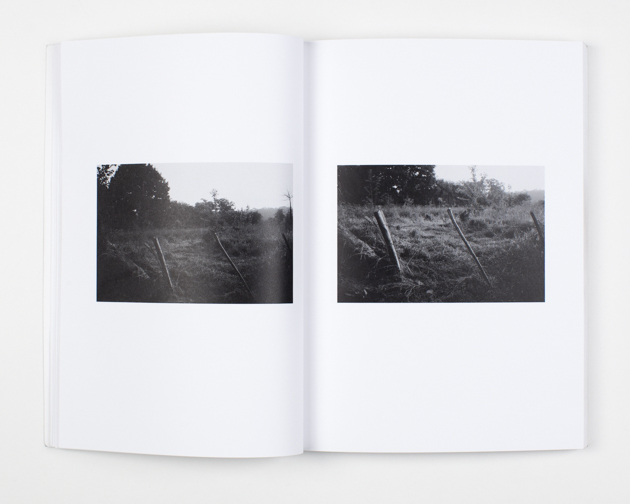
“If all photographs are afterimages — traces and disclosures of an ever-changing world — what is gained by foregrounding this fact? Always previous and elsewhere, images reveal people we’ve known, know or may never meet, as well as places we’ve been or may never visit. They linger, reinforce or displace memories, and come back in unexpected ways. A personal reflection on the vagaries of photographic vision, Colin Stearns’ self-described photo-novel Meridian gathers three years of peripatetic images taken in France and New York City. Modest and unassuming, the images follow the life of a young man on the move with a camera. Alone and restless, he gazes at the world from a distance and moves through a landscape of foreign cities, parks and wilderness, and the confines of anonymous hotel rooms and flats. Less romantic autobiography and more philosophical missive, Meridian points to a past that is slipping away and yet held still in mute images. ” – Adam Bell
Visit Photo Eye to read the full review
Gallery 3 Student Exhibition: “EMPOWER”
Gallery 3 presents “Empower”
66 5th Avenue, 3rd Floor
(Image by Hallie Turner)
This exhibition is a representation of what different artists, whose gender is marginalized in some way, find empowering for them. This exhibition takes place during Women’s History Month and collects works which demonstrate the importance of intersectionality in feminism.
Featuring work by current BFA and MFA students Alison Viana, Azzah Sultan, Cassie Basford, Elizabeth Hernarine, Gabby Pignanelli, Hallie Turner, Jeana Lindo, Megan Tepper, Nicole Vega, Roberto Rischmaui, Victoria Rickson, Vix Walker.
Organized by Vix Walker, Hallie Turner and Victoria Rickson.
BFA Photo Alumni Mark Fitton featured on Fotografia Magazine
Mark Fitton’s Intimate Photos of His Parents Explore New Paths for the Parent-Child Relationship
Read the full interview and see his work here: http://fotografiamagazine.com/close-mark-fitton/
Kambui Olujimi (BFA Photo ’02) Exhibits At CUE Art Foundation and the NADA Art Fair
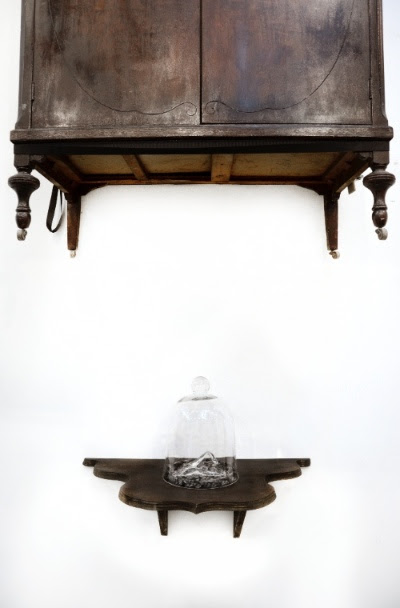
Opening April 7, 2016, Kambui Olujimi presents, Solastalgia, a solo show with the CUE Art Foundation. The exhibition includes large-scale sculptures, silkscreens, and paintings. The works in the show reside at the intersection of numerous issues of current concern to me: the condition of New York City and the nation including gentrification, police killings (both by and of the police), as well as the challenges of commemoration and loss.
The term solastalgia was coined by Australian philosopher Glenn Albrecht in 2003. Essentially it is the feeling of homesickness when one is still home. “Solastalgia is when your endemic sense of place is being violated,” Albrecht describes. Though the term originally references the psychological displacement of farmers due to climate change, I use it as a lens to examine the psychological dynamics tied to the rapidly changing five boroughs.
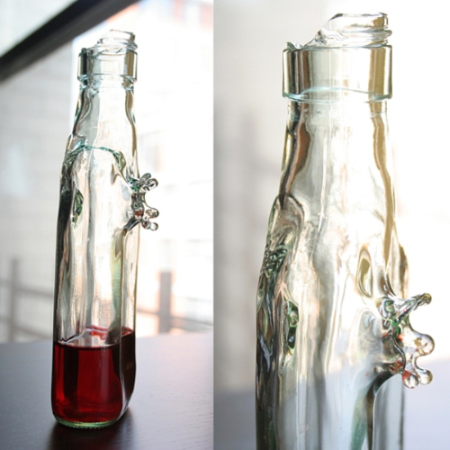
Olujimi will also exhibit with collaborator Camilo Alvarex and Samson Projects for the NADA Art Fair in May and September at the Catharine Clark Gallery in San Francisco.
Take A Break From Midterms: Spring Breakers Bash! Wednesday, March 9
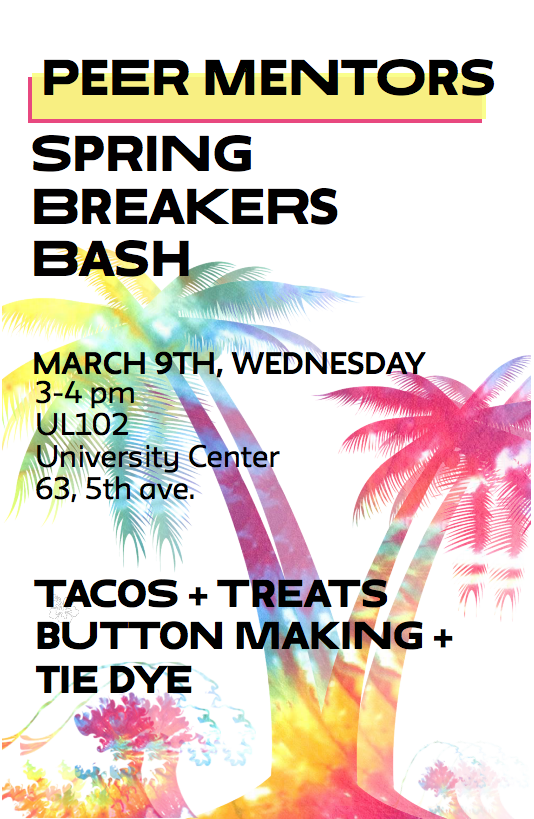
Peer Mentors / Spring Breakers Bash!
Who: Parsons First Years, AMT Undergrad Sophs and Juniors!
Join us for
Tacos + Treats
Button Making + Tie Dye
Wednesday – March 9th 3 – 4pm
University Center, 63 Fifth Ave.
Star Foundation Room
UL 102
Aperture / Parsons Artist Talk: Dru Donovan
Aperture Foundation, in collaboration with the Department of Photography at Parsons School of Design, is pleased to present an artist talk with Dru Donovan. (more…)
Triangle Arts Artist-in-Residency, Parsons BFA Photo Student Lior Tamim, Opening Event 12/3

Lior Tamim, BFA Photography Senior
Lior Tamim, BFA Photography Senior at Parsons, is an artist-in-residence at Triangle Arts Association in New York City. He will be in residence there in November and December, working on his site-specific installation work. Tamim incorporates a wide variety of media including photography, video, performance, painting, and sculpture. Join him and fellow artist resident Pia Mannikko for their opening event on Thursday, 12/3.
Building Bodies: Pia Männikkö & Lior Tamim Thursday December 3 from 6–9 pm
Triangle Arts Association
20 Jay Street, Suite 318
Brooklyn, NY, 11201
Triangle artists-in-residence Pia Männikkö and Lior Tamim invite you into their studios to see works-in-progress that explore the limits of the human form.
Pia Männikkö constructs installations and photo collages that document and abstract the body as organic entity. Her practice explores the presence of the physical form as well as its interaction with the surrounding environment. Tamim transforms his studio into a vibrant red cube which serves as backdrop for an ongoing performance of the artist as body-builder. His collaborative and sitespecific installation negotiates complex questions about masculinity and power. Realized during their residencies at Triangle, the works on view by these two artists ask us to ultimately consider the body as malleable material. Pia Männikkö graduated from the Glasgow School of Art’s Sculpture and Environmental Art Department in 2010 and earned an MFA in Sculpture from the Finnish Art Academy in 2014. Her materials and methods are diverse—from everyday objects, textiles and clay to photography and video. Männikkö´s installations and sculptures have been presented in various exhibitions and art happenings, among others Mänttä Art Festival and Rovaniemi Art Museum in Finland, OpenART biennale in Örebro, Sweden, Armory Gallery in Sydney, Australia, Kraftwerk der Rathenau-Hallen, Berlin, Germany and The Royal Scottish Academy in Edinburgh, Scotland. Männikkö is an artist-in-residence at Triangle Arts Association through the support of the Finnish Cultural Institute in New York.
Lior Tamim is a visual artist living and working in New York City whose projects are installation-based and site specific, as each dictate unique rules and methodologies. He incorporates a wide variety of media including photography, video, performance, painting, and sculpture. He studied art and photography at Bezalel Academy of Art and Design Jerusalem and at Parsons, The New School, New York. Tamim is currently training to be a body-builder while he is in residence at Triangle from November—December 2015.
Triangle Arts Association is a NYC based non-profit arts organization founded in 1982 to support international and U.S. artists. Triangle’s core initiatives: Residencies, Workshops and Public Programs are centered on dialogue, experimentation and the creation of community around art. www.triangle-arts-association.org
For more information, visit TAA’s website.
MFA Photography Alumni Book Release
 MFA Photo Alum Magali Duzant announces the release of her first artist book, I Looked & Looked, published by Conveyor Editions. The book will be launching at the NY Art Book Fair at PS1 this week ( Sept 18-20 ).
MFA Photo Alum Magali Duzant announces the release of her first artist book, I Looked & Looked, published by Conveyor Editions. The book will be launching at the NY Art Book Fair at PS1 this week ( Sept 18-20 ).
She’ll be doing a signing on Saturday, September 19th at 3 pm ( Conveyor Editions, Table Q05 ).
“The book has been a labor of love and I’m so excited to be able to share it. On September 25, 1923, Georgia O’Keeffe and Alfred Stieglitz wrote each other love letters containing a description of the full moon. Inspired by the synchronicity of this romantic exchange, I asked twenty individuals to describe the full moon on October 29, 2012, from their vantage points across the country. The surprise of Hurricane Sandy led to wildly varying accounts of a single sky. I Looked & Looked weaves these narratives together with a series of my images in a lyrical reflection on the natural world as a source of interconnectedness.”
The book will be available for purchase here : www.conveyoreditions.com
An official release party will coincide with the 3 year anniversary of Hurricane Sandy next month, details and invitation to come.
In addition, she will have a limited edition print available at Conveyor’s table.
Upcoming Exhibitions in Australia
Duzant will also be in Australia for two exhibitions in Tasmania and Sydney as well as a Visiting Artist position at Parramatta Artist Studios, and running an abbreviated version of Live Streaming Sunset for the Parramatta Lanes Festival alongside video work by the Australian artist Ella Condon.
Find out more at magaliduzant.com.

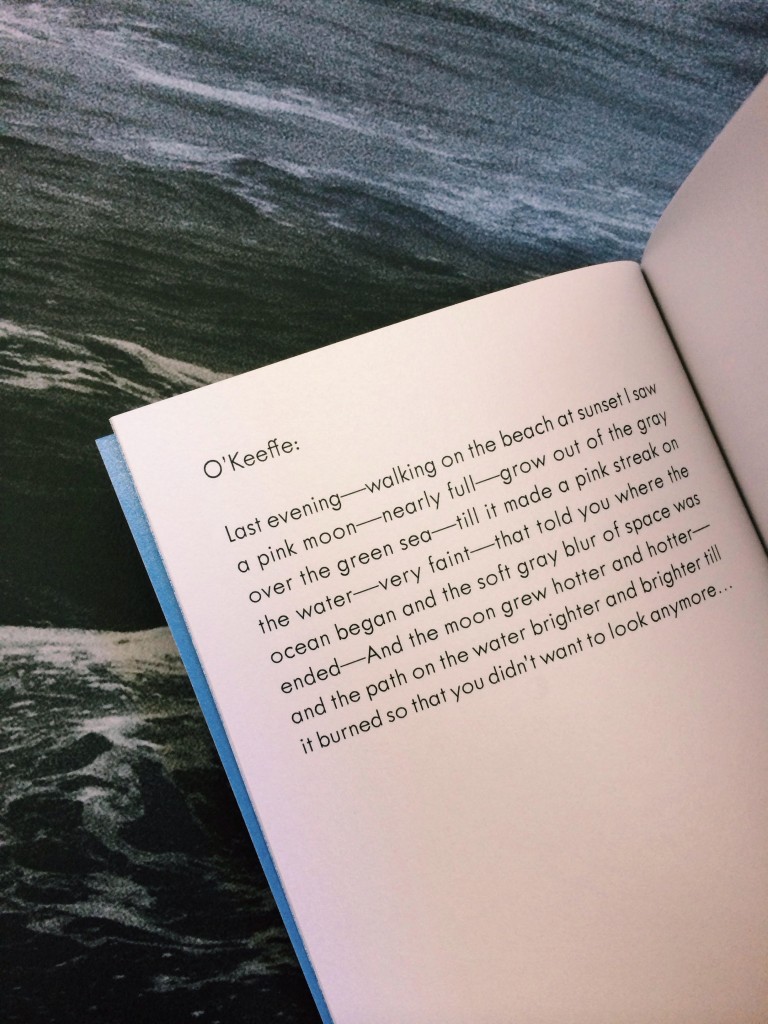
PUSH / PULL: MFA Photography Thesis Exhibition 2015 Closes September 9th

On view: August 10 – September 9
66 Fifth Avenue New York, NY
Opening Reception: August 26, 6:30 – 8:30pm
View and download the catalog featuring artist interviews here
Artists:
Marco Bell
Shiang-Jiun Chen
Hu Qiren
Dongli Huang
Dongmin Lee
Rosana Liang
Ashley Middleton
Kelsey O’Brien
Masahito Ono
Melissa Preston
Matthew Scerbak
Emily Shevenock
Follow us on Twitter and Instagram: @ParsonsMFAphoto
Use our hashtag: #pushpull2015
BFA and MFA Photo Students Exhibit in St. Petersburg, Russia
On June 4th, faculty member Thomas Werner opened the exhibition, “The Museum: Within and Without”, as part of an international collaboration with the State Hermitage Museum in Saint Petersburg, Russia. This was the7th joint project with the Hermitage and one of our best. Parsons MFA and BFA students; Andrea Ibarra, Amanda Strukus, Ashley Middleton, Kalman Pool, Kelsey O’Brien, Kyle Meyer, Margaret Friedman, Marissa Fey, Martim Passos, Sarah Yee, Sofia Colvin, Varvana Mikushkina, Umber Majeed, Veronica Constabile, and Yuner Shao participated in the exhibition. Kyle and Yuner joined a post opening discussion regarding the exhibition via skype.
“The Museum: Within and Without” explores not only architectural representation, but the museum and the city itself as a context for conceptual exploration. Andrea Ibarra’s photographs take quotidian architectural spaces and recontextualize them as beautiful and elegant abstractions. Amanda Strukus has utilized imagery found on Google search to create idealized social spaces that are a reflection of societies frequent desire to present altruistic representations of the everyday. Kelsey O’Brien and Ashley Middleton use the city as a stage to question our role in a contemporary urban context. Alternately, the urban spaces in Kyle Meyer’s photographs deal with the area between life and death. Each of these young artists, as well as the others in this exhibition, ask us to consider a specific social or cultural aspect of our lives and our societies. Many of these themes are universal, resonating across both our cultures, others are specific to the urban spaces within our respective communities. All of the imagery in the exhibition serves as a stepping off point for the larger social, technological, and art cultural conversations taking place in both our countries, which has always been one of the strengths of this collaboration.
Interview with Aurélien Nobécourt Arras, Class of ’15
WHERE ARE YOU FROM ORIGINALLY
I was born in Pennsylvania. I moved to the Paris area when I was five years old, and moved to New York at seventeen.
WHAT ATTRACTED YOU TO THE BFA PHOTOGRAPHY PROGRAM AT PARSONS AND HOW’S IT GOING SO FAR?
I’d never heard of Parsons until I began looking into college options. I remember meeting with Arthur Ou, head of the department at the time, who made a good impression. I never realized how thorough a photographic education would be until I began going to school for it. I think Parsons is known for how intense it can be, and when you really get into it you can start living around making work, looking at work, thinking and talking about work all the time. There is no limit to how seriously you’ll take it, or what your work ethic is. I don’t know how other photo programs are, but I can tell how Parsons Photo just sort of goes with what you are doing – even if you’re lost as to what that is. I think we always respect each other’s work, and that we are all making something different. Still, we’re a small enough group that we’re almost forced to feed off each other all the time. You see what people around you are making, the prints that were left behind, the ones hanging in the hallway or in the trash; the kind of subjects people bring in, the music they play when they shoot (or edit work), all these things set the mood for a creative space in which we live daily.
WHAT IS YOUR FAVORITE CLASS AND WHY?
My favorite class at Parsons was probably George Pitts’s ‘Picturing Sexuality’, which I took in 2013 and changed the way I made pictures. My thesis project was born in that class; it was like a switch. Something changed for me, and my work has been growing since.
Other noteworthy classes are Landscape & Space,
HOW DID YOU BECOME INTERESTED IN PHOTOGRAPHY?
I don’t know. I just remember myself with a small point-and-shoot, looking around curiously and making bad pictures. I would photograph flowers and smiles and the Eiffel Tower and sort of ponder at the frozen results. I think I responded so much to the medium because it was so silent. I’ve been hard of hearing since as long as I can remember, and I found refuge in the quietness of photographs. I think this “quietness” is visible somewhere in my work. I also have bad eyes, but the difference is that when you can’t see something properly, you can still see it a little, you can move around and get closer and gradually identify it – but if you miss a sound, there’s no way to know it.
WHERE DO YOU SEE YOURSELF IN TEN YEARS? WHAT ARE YOUR PRIMARY GOALS?
Ideally, I hope to work for myself. Living off my work, showing it to whom might be interested. Despite my traditional aesthetic, I’m looking at contemporary issues that have relevance today. I want to spark dialogue and conversation but with questions more than statements. Using myself as a visual thread that I manipulate, I can remind the viewer that the standards we live by today – such as gender categories, one example of many – are all constructs. Once we realize that, it can empower us to change our habits and mindset as individuals. By getting used to our daily powerlessness, we begin to think our actions or opinions have ceased to matter.
WHAT KINDS OF THINGS SPARK YOUR IDEAS?
Human behavior. I observe a lot around me, am affected by kids a lot. I always think about my life, my choices, and how they affect who I am and how I think in ways I can’t even grasp. However, I always have a hard time remembering my childhood, so what triggers my work stems from more recent experiences. I’m always amazed at how all these broad and ‘abstract’ notions of gender, race, class, hierarchy, balances of power etc are constantly happening all around us every day, enforced or fought, consciously or not. There is so much to look at in human behavior – and that’s why we should leave animals alone by the way.
WHAT INSPIRES YOU AS AN ARTIST? AND WHAT ARTISTS HAVE INFLUENCED YOU THE MOST?
I’ve always relied on inspiration from artists for visual aims over conceptual ones. In that sense, I definitely owe one to Robert Mapplethorpe, who has been influencing all of my portraiture work since day one. In that vein, George Platt-Lynes, Walker Evans, Duane Michals, Bruce Weber, Manuel Álvarez Bravo and Matthew Morrocco.
I’m currently working on a book around the landscape and architecture of Cuba, where I studied abroad last year. Documenting nature and our footprint on it has always been my first passion. I’ve loved Robert Frank, Lewis Baltz, Eugene Atget, Edward Burtynsky and Sebastião Salgado.
Interview with Marlene Scheurlen, Class of ’15
WHERE ARE YOU FROM ORIGINALLY
I was born in Hamburg, Germany and raised outside of Boston, Massachusetts.
WHAT ATTRACTED YOU TO THE BFA PHOTOGRAPHY PROGRAM AT PARSONS AND HOW’S IT GOING SO FAR?
Parsons was part of my plan to live in New York City. I had heard enough good things about the school to push me to apply, and it became my first choice. I had my heart set on living in New York City almost out of the blue – I’m not one of those people who always wanted to move here. I never had any inclination to do so until the year I applied, I just wanted to stay living abroad. But I just suddenly decided – as I do with most big decisions – I wanted to move to the city. I guess it had to do with being surrounded by a group of artists in Tel Aviv. They always talked about it – how they wanted to move to NYC, how much they love the city, or how much they wanted to visit or live there. And I was shooting a lot of photography at the time, just amateur stuff. I knew very little about cameras, but it became a passion and I decided on it as a career move. So everything kind of unfolded, as things do, and I ended up here. And it has been pretty awesome. I’ve gotten so much out of this school, and the life I built here, more then I could have anticipated. It kind of blows my mind how much I’ve grown up in the last four years, how much we all have.
WHAT IS YOUR FAVORITE CLASS AND WHY?
Right now it’s my thesis course. I have George Pitts, and I think he’s the cats pajamas. He has such a calming demeanor, it puts you at ease. And it’s very comforting, in all the chaos, having a professor like him take a genuine interest in my work. The class has allowed me to build my thesis the way I want to, at the pace and process I work best at. I’ve been given a necessary freedom in the work I am producing, and I really appreciate that.
HOW DID YOU BECOME INTERESTED IN PHOTOGRAPHY?
One summer, when I was around ten years old, I was walking with my father through a city in Austria and – probably out of boredom – he told me that if I jumped into a public fountain he would buy me a camera. So I jumped into the fountain, and he bought me a camera. It was a 35mm Canon – I’m part of the final remnants of a generation who grew up without digital cameras, so I learned through film. And since then I carried photography with me as I grew up. It is one of the only elements of my life that has stuck with me.
WHERE DO YOU SEE YOURSELF IN TEN YEARS? WHAT ARE YOUR PRIMARY GOALS?
I really have no idea where I see myself – I don’t know where I’ll be in the next year. But I know I want to be a documentary photographer. And I want to travel. So if the stars align and my dreams come true I’ll make a living as a documentary photographer, hired to be sent on location to document people/places/events around the world to be used to tell, or help tell, stories. I also aim to become a very good at swing dancing. And acting.
WHAT KINDS OF THINGS SPARK YOUR IDEAS?
People do. I love people. And stories. And when I hear all these different stories, and about these different lives, separate from my own, I get ideas – ideas on what I could document that would be interesting, what kinds of stories or lives I could photograph that would make people feel like they’re getting a rare chance to see into a world that is hidden, overlooked or out of reach for them.
WHAT INSPIRES YOU AS AN ARTIST? AND WHAT ARTISTS HAVE INFLUENCED YOU THE MOST?
I’m inspired the most by traveling – I thrive as an artist when I’m in an unfamiliar place or situation (as many of us do). So even if I’m home in NYC, as long as I’m finding something new – something out of the ordinary for me – then I can feel inspired, and that’s when my best shots are taken. I’m drawn to the darker sides of life and living, to the imperfections and irregularities, especially within people. My continuous “behind the scenes/backstage” work doesn’t just focus on the unpolished reality of entertainment scenes, but also in settings like hospitals, farms and homes.
My favorite part about being a photographer is that I have the ability to enter into these different worlds and become directly involved in a scene I otherwise wouldn’t be a part of. Photography motivates my curiosity and has pushed me through to so many interesting situations and people. I’m able to use the innate chameleon side of myself.
I’ve always been in love with Philip Lorca-Dicorcia’s work, which definitely inspired my own work in the beginning of my time at Parsons. But I moved away from that after realizing I have very little patience in being in control of my compositions. My talent lies in un-staged – for the most part – documentary work. When I was introduced to Guillermo Cervera’s work, and hearing him speak about his war photography, that really ignited something in my own work and a realization of what direction I wanted to take. Alex Webb creates such beautiful vibrant images – they’re full of layers, movement and environment – which is something I have been trying to emulate more and more. And Nan Goldin is a big influence of mine: I am constantly documenting my own weird world within the lives, events and environments I surround myself with. But I feel that myself and my work is constantly changing, and so artistic influences are as well.
Interview with Oscar Rivera, Class of ’15
I was born and raised in Brooklyn, and I still live at home with my family.
WHAT ATTRACTED YOU TO THE BFA PHOTOGRAPHY PROGRAM AT PARSONS AND HOW’S IT GOING SO FAR?
Parsons was my dream school. I remember coming here on a field trip when I was a freshman in high school, and getting a tour of the 10th floor labs. I saw students who were working on things I’d never seen before, and they wanted to be here. In my high school “Art,” was just a required elective no one wanted. I was attracted to desires to create and be innovative that are fostered here. It’s been great. I can’t see myself anywhere else.
WHAT IS YOUR FAVORITE CLASS AND WHY?
My favorite class has been Documentary Strategies with Vincent Cianni. It was a great platform to collaborate with other artists, and come together to provide a service to amplify the voices of others. We worked with a local Not-for-Profit organization, and provided them with materials to reach more people with their messages.
HOW DID YOU BECOME INTERESTED IN PHOTOGRAPHY?
I started using photography as reference tool for drawings, and then I was creating photographs that I was responding to more than my drawings, and before I knew it, I was thinking photographically and making work I loved.
WHERE DO YOU SEE YOURSELF IN TEN YEARS? WHAT ARE YOUR PRIMARY GOALS?
In 10 years I see myself teaching art to children and helping them find their creative voices. When I was younger, it was my art teachers who provided me with the support I needed to make art and be proud of what I was making. I hope to one day be that source of guidance for a growing artist.
WHAT KINDS OF THINGS SPARK YOUR IDEAS?
My photographs are driven by a desire to be honest. My personal work is inspired by the relationships in my life, and is intended to represent them in the most authentic way possible. I create photographs as a way to honor the moments I share with the people in my life. I tend to focus on the themes of Hispanic culture, specifically Puerto Rico and my sexuality. When working in a more editorial sense, I try to work within the realm of race and representation, and work primarily with people of color in my shoots. I hope to one day create a publication that provides a source of inspiration for other Artists of color who don’t feel represented in our popular media.
WHAT INSPIRES YOU AS AN ARTIST? AND WHAT ARTISTS HAVE INFLUENCED YOU THE MOST?
I’m most often inspired by the people and places in my life. I’ve looked to my family and my home as the jumping board for many of my bodies of work. I’ve been influenced the most by Duane Michals, Nan Goldin, Nicholas Nixon, Sophie Calle and Felix Gonzalez-Torres. They all use “truth” in some regard to drive the work they make, and I hope to one day be included in the same conversation that their work has created.
INTERVIEW WITH MONET LUCKI (BFA PHOTO ’13)
WHERE DO YOU CURRENTLY CALL HOME TODAY?
Brooklyn, New York
HOW WOULD YOU DESCRIBE YOUR CURRENT PRACTICE?
Photographer, Visual Artist
WHO AND/OR WHAT INSPIRE YOU IN YOUR WORK?
My inspiration comes from a variety of sources such as sound art, dominant facial features, light, color, counter contemporary culture, international culture, science fiction, raw emotive states, cinema, video clips, contemporary art and technological evolutions.
WHAT IS YOUR BIGGEST PROFESSIONAL ACCOMPLISHMENT?
This question is difficult as almost every experience within this past year has been monumental and exciting. But overall, right now feels like the most memorable period of my career, for it is just the beginning of an unknown journey ahead.
HOW DO YOU EARN YOUR LIVING?
I currently work full time managing the art department at Ford Models. Aside from my day job, I freelance doing various projects such as retouching, DP work, video editing, production assisting, directing, and photographing for various commercial and editorial clients.
DESCRIBE YOUR EXPERIENCE AT PARSONS
My experience at Parsons will forever impact my artistic development and perception of the world.
WHAT IS THE MOST SIGNIFICANT THING YOU LEARNED AT THE PARSONS?
Parsons, as I’ve learned post-graduation, excelled at maintaining a contemporary, forward thinking environment and provided accomplished professionals as our professors whom guided us to further evolve into independent artistic intellects ourselves.
WHAT ADVICE DO YOU HAVE FOR CURRENT STUDENTS, ABOUT THEIR TIME IN THE PROGRAM OR THEIR CAREERS?
I advise students to get involved in their visual interests outside of school and to consider homework a challenge to experiment, push boundaries, and initiate personal discoveries within their medium. I advise to take advantaged of the wide range of courses that are available. Even if a course doesn’t pertain directly to your major, I encourage students to explore their readily available education. Now I realize every course I took provided subconscious forms of inspiration, which I grew accustomed to implement throughout creative processes.
LOOKING BACK WHAT ADVICE WOULD YOU GIVE TO THE STUDENTS JUST ABOUT TO GRADUATE OR OUR VERY RECENT GRADUATES?
“The Concurrents” Staff Artist Lecture Series w/ Jennifer Soong & Joy McKinney – Thurs. April 2nd
The first installment of The Concurrents lecture series, featuring Jennifer Soong from the School of Art and Design History and Theory, and Joy McKinney from the School of Constructed Environments, is happening on Thursday, April 2, at 12:00 pm, in the Bark Orientation Room (2 W 13th Street, 1st floor).
Jennifer Soong is a poet originally from New Jersey. She began as a visual artist before going on to earn degrees in English and Visual and Environmental Studies at Harvard University. She has written extensively on Elizabeth Bishop and draws her influences primarily from the mid-generation American poets. She is interested in the relationship between text and image and is the recipient of numerous awards including the Joan Untermyer Poetry Prize.
Joy Mckinney is a photographer based in NYC. She received her undergraduate degree from the Atlanta College of Art and her MFA in photography from Parsons The New School for Design. Her work explores social and cultural attitudes towards gender and race through photography and video.
************************************************************
Organized by Niki Kriese of AMT, the second iteration of the staff lecture series is collaborative in focus, pairing like-minded but vigorously independent artists from across Parsons to co-present and discuss their investigations. Events will range from screenings to performance to readings, with each artist crafting their own level of engagement with the audience. Similar themes, such as generosity, human interaction, and movement emerge in their work, but the excitement comes from seeing the distinct approaches and viewpoints collide.
For more information, please contact Niki Kriese kriesen@newschool.edu
INTERVIEW WITH CASEY DOROBEK (BFA PHOTO ’14)
WHERE DO YOU CURRENTLY CALL HOME TODAY?
I live in Brooklyn, New York.
HOW WOULD YOU DESCRIBE YOUR CURRENT PRACTICE?
Thus far, it’s been a continuous cycle of reading, photographing, and editing. But what I am beginning to deeply enjoy is meeting with artists that want to publish work, and helping them bring their ideas to fruition.
WHO AND/OR WHAT INSPIRE YOU IN YOUR WORK?
Just walking around, in and of itself, provides quite a bit of stimulation and inspiration. I am constantly reading and listening to music, as well. Sebald, Borges, Carver, Robbins, MF DOOM, Meredith Monk, Madlib, Sun Ra–a lot of fiction, jazz, and experimental music.
WHAT IS YOUR BIGGEST PROFESSIONAL ACCOMPLISHMENT?
Some things have panned out, but the accomplishments I have my mind on are long term and haven’t been completed yet.
HOW DO YOU EARN YOUR LIVING?
I am currently working as a photographer and archivist at a gallery in Soho. Beyond that, I freelance photographing artwork and publish, with a very close collaborator, different artists’ works under our publishing imprint, RITA.
DESCRIBE YOUR EXPERIENCE AT PARSONS
It was an excellent experience. There are a lot of great minds at Parsons.
WHAT IS THE MOST SIGNIFICANT THING YOU LEARNED AT THE PARSONS?
That an art education is an augmentation of your perspective on the world. This extends beyond art–any form of successful education changes the way one sees themselves and what exists around them.
WHAT ADVICE DO YOU HAVE FOR CURRENT STUDENTS, ABOUT THEIR TIME IN THE PROGRAM OR THEIR CAREERS?
I am not in a place to give much advice. All I can say is to trust your intuition, take in as much as possible, and be kind and critical. More logistically speaking, invest all of your money into your practice. Whenever I come across some money, it always gets spent on books, supplies, equipment–the money always comes back.
LOOKING BACK WHAT ADVICE WOULD YOU GIVE TO THE STUDENTS JUST ABOUT TO GRADUATE OR OUR VERY RECENT GRADUATES?
Create your own opportunities, and in Bukowski’s words, don’t try. Just trust yourself, create what you’d like–it may have success now, it may have success in 20 or 100 years.
Interview with Kelly Reilly, Class of ’15
WHERE ARE YOU FROM ORIGINALLY
New Jersey.
WHAT ATTRACTED YOU TO THE BFA PHOTOGRAPHY PROGRAM AT PARSONS AND HOW’S IT GOING SO FAR?
I wanted to study in New York City. I was initially impressed with the program at Parsons because, in addition to having the privilege to study with such an impressive roster of art professors, I would have the freedom to take courses at the other New School universities. It’s a total dream school, and it’s going well!
WHAT IS YOUR FAVORITE CLASS AND WHY?
Any class taught by Jill Enfield or Martha Burgess. They’re tremendous professors and they’ve been such influential people in my life. I’ve also loved all of my Art History courses, particularly one called “Women in Art from the Renaissance to Present”.
HOW DID YOU BECOME INTERESTED IN PHOTOGRAPHY?
I kept seeing these really great Tim Walker spreads in Harper’s Bazaar when I was a Junior in high school (and ironically I haven’t taken a single fashion photo at Parsons). I asked for a camera for my (17th) birthday that year. After a summer class at this wonderful place called Maine Media Workshops and some black&white darkroom training with a mentor in New Jersey named Markam Keith Adams, I fell completely in love with photography.
WHERE DO YOU SEE YOURSELF IN TEN YEARS? WHAT ARE YOUR PRIMARY GOALS?
I plan to go to graduate school for my MA or MFA. I will always make pictures, but my primary goal is to have a career in publishing as a Photo Editor or Photo Director.
WHAT KINDS OF THINGS SPARK YOUR IDEAS?
Everything! I’m always thinking of new projects. I’m kind of a workaholic.
WHAT INSPIRES YOU AS AN ARTIST? AND WHAT ARTISTS HAVE INFLUENCED YOU THE MOST?
PHOTO FACULTY JEANINE OLESON ARTIST TALK | MARCH 10, TUESDAY 6PM
SVA 133 West 21 Street, 101C
Talks are free and open to the public.
INTERVIEW WITH CHARLES HARBUTT | BFA PHOTO FACULTY
WHAT PROJECTS ARE YOU CURRENTLY WORKING ON?
I stopped working on “projects” years ago. I was always protective of my freedom to make any picture I wanted, any way I wanted, any time I wanted. Projects took away that freedom and were a distraction.
As our brains evolved, we started to think we needed laws, rules: “Cross at the green, not in between.” In New York, where jaywalking reigns? I think the result is we’ve lost our trust in instincts; we’re trained not to trust them but control them – to reduce life to a set of rules, concepts. But in art, in making things, there are no rules. If you think you know a rule, try breaking it. You might take a great or at least an original photograph.
In a way, my teaching is about freedom. I think that’s the great seductive metaphor of all art – dance, music, poetry, painting, photography – it’s about freedom both for maker and viewer.
WHO OR WHAT INSPIRES YOU IN YOUR WORK?
The life around me.
WHAT LED YOU TO CHOOSE PHOTOGRAPHY AS A CAREER?
It was the only medium that could even pretend to be in touch with reality.
The content of a photograph as opposed to its subject interests me, both in my own work and in teaching. It takes students a while to see this, that photographic qualities such as tonality, distance from subject, shapes, framing, all these things, inform the meaning of a photograph more than the subject matter and making a student aware of this may reveal to them what – to give one example – their real emotions about their family are from what they believe is nothing more than a family snapshot.
I love photography because you can’t define it. It’s true that photography is a medium where a thing itself makes its own picture, but what that thing is, is very slippery. I like pictures that boggle the mind, when they expand the notion of what is real. You can’t do that in another medium because you don’t start with anything real. As long as you’re faithful to the notion that whatever you’re looking at was actually in front of the camera one time or another, and hasn’t been fiddled with, you’ve got a very interesting medium because you’re not talking about artist’s conception, you’re talking about life.
WHAT ACTIVITIES DO YOU ENJOY OUTSIDE OF WORK?
Reading, music, films, food…
WHAT DO YOU ENJOY MOST ABOUT TEACHING?
I encourage students to work instinctively, rather than to illustrate concepts. All over the world cameras are basically the same. What’s going to be the difference between your work and everybody else’s? It’s not going to be technique. It’s what you feel. Shoot what you feel something strongly about. Look, you like ice-cream. Take a picture that shows how that sundae looks to someone who loves ice-cream.
WHAT ADVICE DO YOU HAVE FOR OUR STUDENTS ON FOLLOWING THEIR PASSIONS AND PURSUING A CAREER IN PHOTOGRAPHY?
Keep your photo career your own.
Interview with A. Retina Stewart, Class of ’15
(photo credit Suzanne Darcy, BFA Photo ’15)
WHERE ARE YOU FROM ORIGINALLY
I am originally from Houston, Texas (and very proud)!
WHAT ATTRACTED YOU TO THE BFA PHOTOGRAPHY PROGRAM AT PARSONS AND HOW’S IT GOING SO FAR?
I was initially attracted to the BFA Photography Program at Parsons because of The New School’s reputation for artistic brilliance and the broad network that comes along with Parsons’ name. I was inspired by the idea that I could be among the alumni to graduate from an institution that has such a respectable list of talent. My experience within the Photography Program has exceeded everything that I could’ve imagined! I have received amazing guidance from my professors who have mentored me to be able to approach “lifeaftergraduation” fearlessly. Also, my peers in the Photography program constantly spark my creativity.
WHAT IS YOUR FAVORITE CLASS AND WHY?
My favorite class is Professional Practices. I now understand branding, promotion, and the business aspects of the professional art world. Knowledge I’ve acquired in this class makes me more secure about fending for myself as an artist. Real world experience is always appreciated sooner rather than later!
HOW DID YOU BECOME INTERESTED IN PHOTOGRAPHY?
I first became interested in photography during high school, but decided to take it seriously my first year as an undergrad at the University of Houston before transferring to Parsons. I always interviewed and photographed my friends recreationally, so the transition into seriously studying the genre was easy for me. I remember coming across the theory that it is easier to recall the details within a photograph of a person than it is to remember what they once looked like when you were facetoface with them. That’s when I really fell in love. The idea of being able to freeze time and revisit moments whenever I want is a compelling experience that I am privileged to have.
WHERE DO YOU SEE YOURSELF IN TEN YEARS? WHAT ARE YOUR PRIMARY GOALS?
I’m currently working on my thesis, “The Underground Project” that documents emerging hip hop artists. In ten years, I hope to provide a more structured platform for the artists I work with to be seen/heard whether through a nonprofit organization or a recording label of some sort. Regular international travel is definitely in the plan as well. My primary goal on this Earth is to inspire others among my journey; wherever it takes me.
WHAT KINDS OF THINGS SPARK YOUR IDEAS?
Words and how people use them really spark my ideas. Many people don’t take the time to really understand the words they speak, but when people truly do; I notice. I find that very special. So, more than anything a deep conversation or a powerful song really moves me.
WHAT INSPIRES YOU AS AN ARTIST? AND WHAT ARTISTS HAVE INFLUENCED YOU THE MOST?
Unique perspective and substance inspires me the most as an artist. There’s nothing more powerful than an artist who believes that they have a new way of seeing the world and invite the world to understand their point of view along with them. The most influential artists to me have been Wangechi Mutu, Kid Zoom (Ian Strange) and Tupac Shakur.
PHOTO FACULTY CARLOS MOTTA SOLO EXHIBITION | 2015.01.24 – 2015.03.22
Röda Sten Konsthall is proud to present Carlos Motta: For Democracy There Must Be Love, the first survey exhibition of Colombian artist Carlos Motta.
Presenting a selection of installations, videos, sculptures, and documentary-based works from 2005 to 2014, the exhibition highlights Carlos Motta’s ongoing preoccupation with democratic representation and the repression of individual and collective civil liberties. Promoting the act of self-representation, Motta creates works that question the writing of history, the construction of political memory, and the normative discourses of sexuality and gender, arguing that the state of democracy cannot exist merely by means of tolerance and inclusion. True equality and freedom demands systemic transformations that allow ways of self-government: Being human is being beyond parameters – without sex, gender, ethnic, racial or social constraints. But, how can this ideal be attained?
Carlos Motta: For Democracy There Must Be Love focuses on Motta’s investigation of the history of the subordinate sexual body by drawing parallels between pre-Hispanic and colonial cultures in Latin America and contemporary queer politics. Creating discursive platforms to enable conversations around matters of sex and gender as issues of social justice, Motta’s work challenges the traditional grounds of society—from the violent imposition of sex as a legal and a moral category, to the hegemonic authority of the Church, to the State’s regulation of bodies and identities.
The exhibition features the installation Nefandus (2013-2014), which includes Nefandus Trilogy,three beautiful and haunting films that study pre-Hispanic homoeroticism and the brutal stigmatization of sexuality during the European colonization of the Americas; and We Who Feel Differently (2012), a video installation that addresses critical issues of international contemporary queer culture in the light of forty years of LGBTI politics.
The survey also includes documentation from three pieces of Carlos Motta’s Democracy Cycle(2005-2014): Deus Pobre: Modern Sermons of Communal Lament (2011), Six Acts: An Experiment in Narrative Justice (2010) and The Good Life (2005-2008) – all works that investigate the construction of political memory in Latin America by using performative interventions in the public sphere. READ MORE
Curated by Aukje Lepoutre Ravn.
PHOTO FACULTY JEANINE OLESON CREATIVE CAPITAL GRANT RECIPIENT
A human(e) orchestra is an umbrella over a series of performances, workshops and a film with an ensemble brought together to enact various compositions that range from conventional music to physical labor to speech acts. The first of the series, Hear, Here, was performed in June 2014 and will develop into a film. Subsequent projects are working from the collectivity of people to produce noise around a series of agreed upon issues and audiences in need of music or temporal arrangement approaching unity. This “music” will occur through the commissioning of appropriate scores, instruments, workshops and then the presentation of discrete works in varied spaces ranging from traditional exhibitions and theaters to web and film. READ MORE
Jeanine Oleson is an artist whose practice incorporates interdisciplinary uses of performance, photography, film/video and installation work. She attended the School of the Art Institute of Chicago and Rutgers University. Oleson has exhibited at venues including The New Museum, MOMA/PS1, White Columns, Art In General, Socrates Sculpture Park and Exit Art in NY; Commonwealth & Council and L.A.C.E. in Los Angeles; Beta-Local, San Juan, PR; and Grand Arts in Kansas City, MO. Oleson has received a Franklin Furnace Fellowship and a Jerome Foundation Travel and Study Grant in 2009; Brooklyn Arts Council Community Arts Regrant, 2008 and 2009; and a Professional Development Fellowship, College Art Association, 1999-2000. She has been an artist in residence at The New Museum, Skowhegan School of Painting and Sculpture, and Smack Mellon Studio Program. Oleson is an Assistant Professor at Parsons the New School for Design.
Photo Faculty Sarah Palmer “No Whiteness Lost” Interview with Baxter St Camera Club of New York
This week I had the pleasure of meeting with photo-based artist Sarah Palmer. Here in her studio at The Invisible Dog Art Center, Sarah arranges, photographs and re-photographs small assemblages to produce thoughtful, highly literary images. For me, Sarah’s insights into photography, literature and her current project, No Whiteness Lost underscore the importance of continually connecting with and learning from other artists.
Liz Sales: You have so many Polaroids here!
Sarah Palmer: I have hundreds more. I shoot 4×5 film with strobes, so Polaroids or, these days, Fuji Instant packs help me to pre-visualize my images. A photograph is such a different visual experience than real-life seeing.
Liz Sales: But these don’t always serve a solely utilitarian purpose, do they? You include Polaroids in your still-lifes —for lack of a better word.
SP: Yes,I like to include photographs as physical objects within my images. I think of them almost at mirrors that reflect inward, eliminating the elusive “viewer,” creating an almost disturbing psychological space.
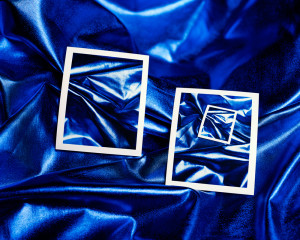
Mirror Dance, 2014
LS: Is this something you’re exploring currently?
SP: Yes, in many different ways. I’ve been slicing up old prints and putting them back together. For example, this is an image of a balloon that I composited with a Hubble Space Telescope image of the birth of a star. I took the same image, inverted it and printed that, as well. I combined the images and re-photographed the collage. There is this hard shadow, cast onto the background, which a real balloon would never make. I think this non-indexical quality widens the gap between what an object is and what an image of an object is, which is an important idea in my work.
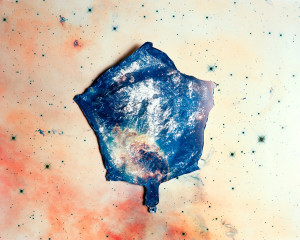
Nursery (Carina), 2014
Liz Sales: So, this is part of a larger body of work?
SP: Yes, this series is called No Whiteness Lost. I borrowed it from a line in The Descent, a poem by William Carlos Williams. He became one of my favorite poets, when I was studying literature in college.
LS: I’m not familiar with The Descent. Could you tell me about it?
SP: Williams wrote, “[N]o whiteness (lost) is so white as the memory of whiteness.” He wrote this poem as an older man, and, to me, it really articulates the way memories transform as time passes. I don’t remember events as vividly as I remember feelings and emotions. If you asked me about a novel or a film, I would be more likely to recall how I felt when I read or watched it, the color or formal elements, the music and the tone, than the plot. That’s why I’ve appropriated No Whiteness Lost as the title for my series – I’m interested in making pictures that create color/form, “music,” and tone rather than narrative.
LS: That resonates in Object (Swann), which references Proust’s idea of the fallibility of memory. Are literature and poetry significant to your work in general?
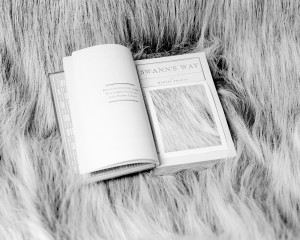
Object (Swann), 2014
SP: Yes, text is always significant to my work. While making this work, I’ve also been thinking about the lead light and empty horizons – a sense of ecstatic futility – in Beckett’s Endgame, as well as the whiteness of Melville’s white whale, as a metaphor for horror.
LS: Whiteness as a metaphor for horror in literature often references Colonialism and racial dominance. Is that idea relevant to your work as well?
SP: That is quite a complicated question for me. I resist the didactic in my work. I am politically concerned but have a complex relationship to activism, and I struggle with how to engage these issues in my work. Perhaps this will change over time, as I mature as an artist. Photography is such an easily illustrative medium and I thwart clear narratives; rather the “whiteness” I reference here has the power to blind with glare, to obscure, to create blank space.
Hence, I tend more toward philosophy, looking at artists and poets who explore ambiguous spaces, including Williams and H.D. among Modern poets; Samuel Beckett; my father, the poet Michael Palmer; the poet Robert Duncan and his partner, the artist Jess, (both were close friends of my father’s); the poet and painter Norma Cole, (also a friend).
I’m also drawn to contemporary artists who engage with photography in fascinating ways, including my husband Dillon DeWaters, Sophie Ristelhueber, Viviane Sassen, Gabriel Orozco, Sigmar Polke, R.H. Quaytman (herself, the daughter of a poet, Susan Howe), Leslie Hewitt (whose work engages in a fascinating way with history), my friend Lucas Blalock, the brilliant Paul Chan, Lorenzo Vitturi, whose work I just discovered, and I could go on for pages and pages. It is really important for me to be part of a community, even if is a community of influence, artists I don’t know. The smallness, the inter-connectedness, of the world makes it more engaging to me.
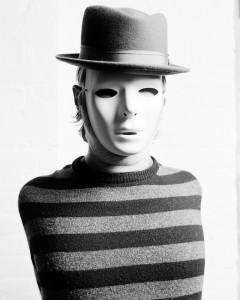
A Shadow is a Shadow, 2015
LS: That reminds me of a conversation I had with Dillon. He also stressed the significance of being part of a community of influence and the importance of artists, filmmakers and writers being in conversation with one another through their work. How does being married to and sharing a studio with another artist influence your practice?
SP: Dillon’s and my work are hugely influential on one another. When we met ten years ago, we were in love with photography, with the history of photography. For both of us, that relationship to photography has evolved and developed, has transformed, really, into a more complex and interesting one, into an art practice. Both of us have moved away from more traditional forms of photography, into ourselves and our psyches, finding sources in other artworks rather than just in the field. We also have a son now, which makes an art practice both far more difficult and incredibly, more necessary. We have had to make peace with our pasts, so to speak, and in my case, that involves embracing my love for words and the way words make my heart race, create electricity in my head. That’s what I desire from my work.
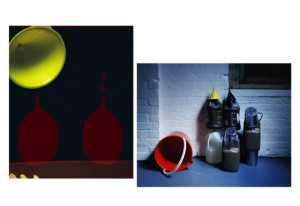
Polke 1969 (Perfume Picture), 2015
We also end up photographing the same subjects, from time to time, on our own. We are actually on the cusp of releasing an ongoing series of limited edition diptychs, Pyramid Editions, one a month in 2015.
LS: Congratulations! It’s also note-worthy to me that you mentioned empty horizons in literature earlier. I’ve noticed that your images tend to obfuscate the horizon line. For example, in A Spiritual Urgency, an empty stepladder seems to exist midway between Earth and the stars, with no distinct horizon line separating the two.
SP: The ladder is actually surrounded by fake “snow” which I created by blurring stars photographed by NASA’s Hubble Space Telescope. I have a memory of being backstage at the ballet while they were testing the fake snow for The Nutcracker—snow falling on an empty stage. It was thrilling, and it stayed with me.
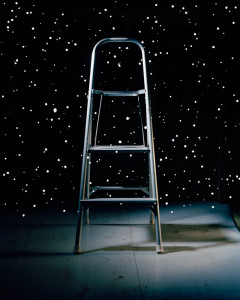
A Spiritual Urgency, 2013
LS: That sounds like a wonderful memory, and hearing about it adds a tenderness to the work. Are you a romantic?
SP: I’m a bit of romantic, but not (I hope) a blind romantic. I’ve thought a lot about the Sublime, ever since reading Edmund Burke as an undergraduate, and have been searching for that heart-stopping and wonderful-terrifying moment, looking over the edge of the cliff (hence, Endgame, Moby Dick, The Descent – apocalypse, horror, facing inevitable death). As a result, my scale has gotten relatively small; I used to make landscape photographs.
LS: I don’t understand.
SP: In my graduate thesis, I was searching for the sublime in America to see if it still existed, post-railroad era—
LS: Oh! Does it still exist?
SP: Nope, not in the German Romantic sense. So, I started to explore the sublime inside my studio, and my scale necessarily condensed.
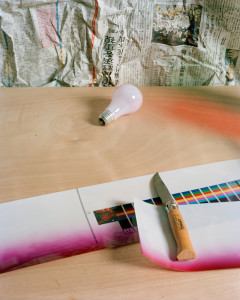
Control, 2013
LS: It’s definitely worked out. In contrast to the small scale you’ve adopted primarily, you also appropriate astronomical images. Could you talk about your interest in space?
SP: What could be more terrifying than the vastness and unknowability of the universe and time, and our relative infinitesimal tininess? The terror I first felt at the idea of non-existence was not dissimilar from the terror of space and infinity, both around age 9. And yet, the Hubble has made these incredibly beautiful, knowable, picturesque images available to us. Even if they are romanticized data approximations, they are so late-80s and fantastic. Black light posters and smoke machines and raves. All-night dance parties.
LS: You’ve found a tension between fear and pleasure, which I associate with the sublime, especially in your depictions of people. Could you talk a bit about your decision to seat your subjects facing away from your camera?
SP: That’s a very good question. I rarely photograph people and I’m not interested (in this work, at least) in making portraits, but people have this inescapable quality, a particular-ness, in photographs. And, therefore, there is something horrifying about removing their faces, which I do with hair or masks or simply by turning them away from the camera. I like to treat people no differently than I would treat any other object in my studio.
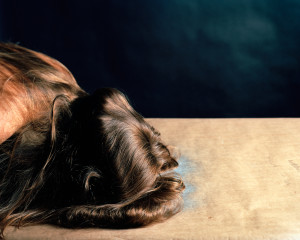
Wove out of the dark, 2012
LS: I’ve noticed that you often use studio supplies, like ladders and buckets, in your work as well. Is that in reference to the artist’s process?
SP: I work intuitively and don’t have preconceived notions going into the studio, so I tend to use what is available. Also, I love the idea of turning something mundane into something uncanny or unrecognizable through context, use against purpose; re-examining ordinary objects, and somehow through that examination transforming them into something radiant. For example, people tell me this image, No Horizon, looks like a scribble, but it’s actually a photograph of gathered tulle.
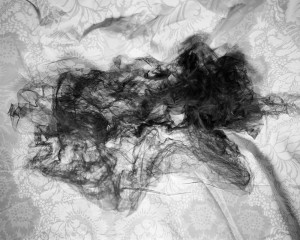
No Horizon, 2014
LS: Oh, I did think that might be a photograph of a drawing!
SP: That’s what I love about tulle! It responds to light in a way that causes it to appear blurry or unfocused on camera. I’m always fighting against the inherent representationality of photography. It’s an absurd and impossible struggle; photography literally re-presents reality. I’m using a medium that is intrinsically representational, and I’m trying to move away from representation.
LS: That’s interesting, because even though you are pushing against the medium in many ways, I find your work to be inherently photographic, or at least self-reflective.
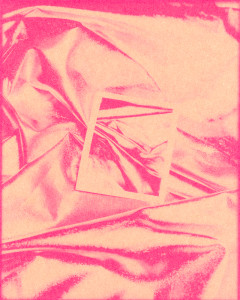
Red Burn, 2014
SP: Oh absolutely, this summer I started a project, making contact prints on construction paper, by leaving 8” x 10” negatives on the paper out in the sun. So, even when I am not using traditionally light-sensitive photographic material, I am still referencing photography. Literature and philosophy are important to my work, but it is always still rooted in the medium of photography.
Photo Faculty Vincent Cianni Gives TEDx Talk at University of Navada
On January 23rd, using images and narrative, Vincent Cianni described how his work documenting gays in the military broadened his own perspective of understanding and accepting the differences of others. Listen to the edited version here.
Interview with Alvina Lai, Class of ’15
WHERE ARE YOU FROM ORIGINALLY
I was born in L.A. and raised in Brooklyn.
WHAT ATTRACTED YOU TO THE BFA PHOTOGRAPHY PROGRAM AT PARSONS AND HOW’S IT GOING SO FAR?
The BFA Photography program has a plethora of resources. The equipment, facilities, and faculty are constantly growing and changing in order to encompass both traditional and contemporary work of varying genres.
WHAT IS YOUR FAVORITE CLASS AND WHY?
I think seminar allows for students to develop strong bodies of work for a long period of time, which allows for growth. Working on one project for a semester (or two) really forces a student to responsibility for their own work and ambitions.
HOW DID YOU BECOME INTERESTED IN PHOTOGRAPHY?
It grew organically from my interest in other forms of art and storytelling. I believe these things are delicately interconnected.
WHERE DO YOU SEE YOURSELF IN TEN YEARS? WHAT ARE YOUR PRIMARY GOALS?
My goal is to keep learning. I would like to continue developing new perspectives.
WHAT KINDS OF THINGS SPARK YOUR IDEAS?
Reading, viewing art, having meaningful discussions, and giving time to quiet contemplation can often lead to an idea.
WHAT INSPIRES YOU AS AN ARTIST? AND WHAT ARTISTS HAVE INFLUENCED YOU THE MOST?
I enjoy the work of Rinko Kawauchi. I am inspired by observing daily life, learning about social issues, and exploring.
MFA Photo Alum Eric Madigan Heck’s Exhibition and Book Signing Tuesday, 2/17
PICTURES NOT CONTENT
Exhibition and Book Signing
NEUEHOUSE
Be sure to rsvp to NEUEHOUSE@NADINEJOHNSON.COM
Interview with Magali Duzant by David Chan (BFA ’16)
Interview by David Chan, BFA ’16 www.davidchanstudio.us is an artist based in Brooklyn, NY. Interests include modern art, structural film, consciousness, and the human condition.
Magali Duzant is an artist based in New York City whose work deals with themes of time, the collapse and tracking of it, the documentation and visualization of the non-physical, and the condition of searching but not knowing what for. In her project Sympathetic Magic, Duzant focuses on using photography as a tool to feed the desire for spirituality and to define something the metaphysical in using different objects, but most notably a year-long collection of aura photographs. In Live Streaming Sunset, she captures sunsets in all 4 different time zones across the United States and projects them continuously in a window in New York City. I sat down with Magali to talk about her beginnings, and how she functions and works as an artist today in New York City, and how the themes of our work relate, being that our work is in conversation and has many overlaps. In my work, I find myself also trying to define something that is extremely abstract and difficult to immediately visualize. We discuss the challenges of making this type of work in depth. I also talked to her about life after grad school, and how it is to live and work as an artist while still making money, which led to a lot of great advice for young artists out there.
David Chan: Hi Magali. I would love to start by talking a little bit about your background- where you grew up, where you did your undergrad, etc.
Magali Duzant: I’m actually from New York. I grew up in Queens and went to high school in Manhattan. I went to an arts high school- LaGuardia (Fiorello H. LaGuardia High School). The “Fame” school – dancing on taxis and shit. My mother’s family has lived in New York for ages and my dad is from the Caribbean—French is his first language and he is adorable. My dad is short and my mother is really tall, so they are like the odd couple.
DC: This explains your last name and your first name, which I’ve always wondered about!
MD: Yeah, Magali Duzant. It sounds fancy, I feel like I have a destiny to grow into it or something. I was really lucky when I went to high school because we took art courses every day. When I was applying to my undergrad, I was thinking I would either apply to art school or to a humanities program and study something like International Relations. I ended up doing both somewhat. I went to Carnegie Mellon in Pittsburgh, and I hated it when I first got there.
DC: You hated the city or the course?
MD: I hated the city, and I wasn’t sure about the course. I ended up loving it, and I did a double major in fine art and anthropology. I technically minored in photography but they wouldn’t let me make photography my main concentration because they didn’t have enough students in the program. While I was doing that, I worked as a production assistant and that’s where I really learned all of my technical skills. I don’t think I picked any of it up in classes the way I did hands on.
DC: Was that on film sets or photo sets?
MD: Both. I think a lot of my work comes out of the fact that I have self-taught myself a lot, and that I’ve done a lot of different things. I worked for a commercial photographer who did huge national ad campaigns, and I did all of his talent scouting and location scouting. I also worked for a photographer who did all interiors, which was a nice thing because we would travel to people’s mansions and shoot for Architectural Digest. I graduated straight into the recession, but I was really lucky. I had interned at a small photo gallery while I was in school, and right as I had graduated, the director was asked to fill the position of curator of photography at the Carnegie Museum and I was first asked to take over to take over installation within a week of graduating. Later, I interviewed for the job of exhibition coordinator and got it, which was amazing and scary, because I just stretched the truth the entire interview. I pretty much
just told them that I had all these skills that I didn’t. And I just sat down and had a complete panic attack, and then just started to teach myself all of these things.
DC: So you learned how to work and function in a gallery, which you never really experienced before?
MD: Yes, it was great because I learned a lot. I learned that I never want to work for a gallery ever again. I learned that working in non-profit was rewarding and incredibly frustrating. After about a year, I decided I wanted to leave Pittsburgh. I applied for a residency in California; I had gone to San Francisco and loved it. I got the residency but I had three months, and so I saved up enough money to travel, and I traveled across the country— I went down to Baja, I traveled up the west coast, took the train across Canada, I came back to New York, went up to Montreal. It was just this amazing time where I thought about work and spent money.
DC: Money well spent, though!
MD: I looked at my savings account, and I thought, “Well, it’s always good to start fresh.” I spent the next two years in California in San Francisco and I was an artist-in-residence at the Kala Art Institute. It was a really amazing space in Berkeley specifically for photographers, printmakers and video artists. I took the time to figure out what I needed to do, and at some point I realized that I was interested in maybe teaching, and it was something that I wanted to continue to do. And that’s when I decided that I wanted to do a graduate program. I knew I wanted a photo program, but I wanted one that was open and I really wanted to be back in New York, so I applied to a number of schools and was deciding between ICP-Bard, SVA, and Parsons. I chose Parsons for the structure of the program, scholarship ( I was determined to not take on debt ), and the connection to the New School. I ended up taking classes in the media studies program which was really great. I enjoyed finding my way to the notion of public art as something I was interested in. It’s exciting and a little overwhelming.
DC: Can you briefly define “public art”?
MD: When I think of it, I think of art that is not necessarily in a gallery space, that exist in communities outside of your typical art realm, so in the live streaming sunset piece, I showed it as part of the thesis show exhibition. But it was really facing the street, so it was available to the passers by; it was accessible to anyone walking by.
DC: So is it important to you that the work is accessible to more than just the art world and this specific crowd?
MD: Yes and specifically with this project, I am capturing a routine, and something that is available to anyone in one way or another and bridging distance. I grew up in Queens and because Queens is such a huge immigrant population I’m thinking about how great it would be to have it there, and how great it would be to bring different viewpoints into one place ( mimicking the make up of the borough ). There’s something calming and soothing about this imagery that I am seeking to bring back, but also to think about, why should something that is public in its essence be made private and specific to a community that isn’t necessarily that open, so to put it back into a public space.
DC: In the more recent work that you have made, like Sympathetic Magic or Live Streaming Sunset for example, are there themes in there that resonate with you? And how long have you been working with these themes?
MD: Time is a huge theme. The collapse of time, the tracking of time, is something that I have become interested in, has been present in a lot of my work over the past few years. I think isolating it as this topic of interest is what I see as this desire in contemporary culture to track, record, and analyze data. The idea of smartphones, social media, that “everyone is a photographer”, that everything is being recorded
in some way, shape, or form, and trying to utilize that in my own work. But to use that to analyze things that are a little bit beyond our normal perception. I think in almost every project, it comes down to- How do we visualize something that we can’t see? How do you visualize the sun setting all over the world? How do you visualize an aura, an energy field, or a belief system? And then they kind of shoot off, because each project brings its own “something” to it, so with the auras, I ended up becoming really interested in translation, and layers of translation through interaction or the terms that we use to describe these unknowable things.
My aunt has a summer house up in the Adirondacks and she tricked me into cleaning out her storage space. It was the worst-best vacation ever. I found this box and there were maybe 40 black and white negatives from the 20’s and a two-tiered slide organizer dating from 1949 to 1970. A stranger’s family’s photos, which was very weird. At that point, I thought a lot about different kinds of archives, the index, and how that worked. The more work I made, the more I see it as this interest in time, in memory, and kind of the vagary of that. How memory is so different from reality but supersedes reality a lot.
When I started grad school, I wanted to do something different and I ended up going back to these slides and making this installation piece. I realized that what I was more interested in was the idea of projection, and really interested in the projector as a tool and as an object as well. I went back into the space and photographed the space where the slide had been taken with a projector screen in it, and I projected the original slide on to this print of this space. That was the gateway project that then led me to thinking about time and how to collapse time and distance. I was missing California a lot, which I didn’t really think I would, and I was having this feeling of dislocation and a lot of it was this urban experience. New York was always sort of pressing in, and I didn’t think it would be a big deal because I grew up here, but I realized that my surroundings on the west coast really affected the way that I thought about things. Leaving it is when I started to become interested in spirituality and the quest for that in alternative means.
DC: So, something you can’t quite put your finger on and define.
MD: Exactly. So this idea of the condition of searching. The condition of wanting more, but not exactly knowing what that is. But also thinking about the internet as this place for it, and using the internet to collapse time and space, and follow these rabbit holes.
DC: I feel like our work has a lot of parallels, in that I’m trying to capture this human experience inspired a lot by traveling on my own. Over the summer I went to Marfa on my own, and this idea of isolation became a big thing for me, and I started reading about existential isolation, and how to understand something that you can’t quite put your finger on that exists for everyone. I’ve never thought about it before this but it’s so true and it’s so overwhelmingly intense. So trying to capture something transient that you can’t define is important to me.
MD: I love the idea of continuing trying to do it. It’s like this impossibility, but there’s something there but that makes me feel like… a part of me thinks that you’ll never do it, but the other side is saying, that doesn’t mean you shouldn’t try, and keep doing it. And there’s something really magical about those transient moments and ephemeral experiences when you are alone and when you’re trying to make sense of something a little bit bigger.
DC: One question I had was about the idea of working as an artist. You have a lot of past experiences doing commercial work, how do you balance that with your fine art interests?
MD: It’s difficult and I think the longer I do it, the more I want to do it, but the more I also appreciate how difficult it is. I was invited back to Carnegie Mellon to speak, to do studio visits with the seniors. I was freakishly positive, and I told them I think you have to treat it like a job, you have to do the work that you actually want to do. It all sounds like throwaway advice or ideas, but it does come down to the fact that
you have to make money, so you have to make work that sells or you have to do something else that supports it and it’s different for everyone. So much of it comes down to knowing yourself, knowing how you work. I personally work part time for an artist book producer, and it doesn’t pay that well, but I do some freelance work to fill in and I teach. I’m still figuring it out and I think being open to that evolution of process and interest is incredibly important. I work my part time job because I have great benefits in the sense of having access to a 9900 printer, a studio space, and I’m working on a book project and they are helping to print. I also know that I don’t work at night, so I keep Wednesdays and Thursdays as strictly studio days, and I’m in the studio all day long and working all day. Being a full-time freelancer is not something I want to do because I feel it’s like an added stress, so to do it when it comes around, but to know that I have a job that pays my bills and my rent is great. It’s a lot about peace of mind and shaping your work life to fit your personal work life in a way.
DC: You talk a lot about the people around you and people you know. Can you talk a little bit more about the kind of company you keep and the people you surround yourself with? How do you fit into a community of artists, even if not a local one? Is it important to surround yourself with people who inspire you, people who you collaborate with and you have similar interests with, or do you have people around you who do completely different things?
MD: I am one of those people who need to have people in my life who are interested in art but are not necessarily as involved in the art world. I have two really good friends in the city – one I went to middle school with, and one I went to college with. My friend Cheryl who I went to middle school with, she has a degree in comparative literature and she works in urban design and planning. My friend Michelle, who I went to college with, we went to art school together. They are both great to go to galleries with and talk about art, but they are also outside of it. So it’s a fresh perspective. It’s important for me to have people in my life who get it but are outside of it, because it’s a small world and can be a little overwhelming. But it’s also really important for me to have a community of people I can show work to, and talk to, and who are making either similar or very different work.
Sometimes it’s really easy to look at what is trendy right now, and look at it and say, “I don’t fit there.” It’s really important to have people who reassure you, and to know that you have your own little section. I’m still in touch with people from school but it’s been really important for me to branch out and to find people who are working but are working in different media. It’s really important for me to be surrounded by people who are creative and actively making or doing, and who are interested in community and how that affects their work. It’s important to stay in touch with professors- with people who are older and working, to have a different generation’s eyes and viewpoint and world view. I try to keep in touch with people that way.
DC: I think that’s great advice to have a community outside of school. I think that’s something that I’m trying to establish for myself, and just to think about things like that in the long run. Because being in school is kind of that… but to think about it in a long term way, is important.
MD: When you’re in school, you have it, in the sense that people have to show up.You’re gonna get a grade, you have to be present, you have to show up. But I think it’s super important to seek out the people who your work is in conversation with and people whose opinions you are interested in. It doesn’t have to mean that they agree with everything, but just people whose opinion you want to know. The wider you make that group, the better it is.
DC: I think the only challenge for me is that I found it a little bit difficult to find people whose work is in conversation with mine. Maybe it’s the specific community I’m in, maybe because it’s school… there’s something about the themes that I’m exploring that is maybe not thought about by people around me. That’s why I was really inspired by your work because I felt it was the first time I saw work within the realm of school that revolves around the same kinds of ideas in my head.
MD: I think the themes you explore are themes where you are really thinking about experience in a deeper way and that’s difficult sometimes to bridge a gap. It’s not a hard theme, but it’s something that is very thoughtful. It’s difficult to show, so how do you visualize it? As far as work relating… It really takes a while. When I was at Parsons, there was this Icelandic girl Kristín who I think I’m on similar parallels with. You would like her a lot. But amongst my other classmates, I found it difficult sometimes… I could talk about my work, but I would feel like there was something that wasn’t quite coming up – people would be silent and I wasn’t sure if it was indifference or dislike. I would thank them for their advice and look at how to apply it, but a lot of times I didn’t feel like we were connecting in a certain way. And sometimes you can’t connect with everyone, some work speaks to the masses, some doesn’t.
DC: Something that I feel is kind of a big challenge with my work is dealing with very abstract themes. In critiques, I’ve gotten the comment where people say it’s really hard for them to have something to grab on to in the work because the themes and the work are really abstract. But in the same vein, I never want to be too literal. Do you feel like you have the same challenges? Because you deal with pretty abstract themes yourself.
MD: Yeah, I find there’s always a fear of being too literal. For the aura project, I was really interested in the back and forth, but also in why I was interested in it. I was interested in figuring out why I was interested, and again the idea of not being able to place your finger on it, but wanting to figure it out. When I was making photographs, I didn’t know what to do because I’m interested in the thought process and all of this bizarre history that goes with it, but in the physical objects. I was working in the studio, and I found it was so easy to fall into these literal ideas. So I started making the video piece. I started mixing in all this new stuff, and it didn’t make sense. People kept telling me, “I don’t know what you are trying to say, and I don’t know what is happening.” And I finally just realized that for me, that was okay. Because that’s what it was. I think I finally got to the point where it was okay because I don’t think I’m making work where I’m hoping the audience is saying, “Oh, I see A+B=C. Great.” It is about being abstract and maybe losing yourself in something. If people have this issue where they can’t find something to grab on to, I think it’s okay. There’s so much work out there that you get immediately. I’d rather be making work that doesn’t reveal itself immediately. People want to be able to define your project immediately, and there’s a lot of one-note work out there. There’s nothing wrong with that— I have done some projects that are like that, and exist in a certain place in space.
DC: I love the idea of the inspiration coming from you trying to figure out something that you’re not sure you can figure out. And replicating that experience for the viewer.
MD: That’s exactly it. It’s saying, “I’m trying to record and show you this process. And this process is still ongoing, and doesn’t have an end.” I think, at least in school, when people say they don’t know what you are trying to do, that’s such a thing to say in a critique when you don’t know what to say and you can’t figure the work out.
DC: In a lot of ways I feel like it’s better to have a project that you can’t ever finish ever, that is ongoing, because it’s more interesting. It’s representative of this lifelong search.
MD: Some of the themes that we are both talking about – why would you be making work if you could tie it up in a nice little package and say, this is what it is?
DC: Exactly, if it had already been figured out, we wouldn’t even be talking about this, I wouldn’t even be making work about it. I like admitting that the work is a work in progress, because I feel that a lot of times in critiques, you show work and you have this confusion of stuff because you are in progress. And people critique it so hard, almost as a final. And I find myself thinking, this is not the final. And even the final is not the final. I think it’s because school is such a mix of different kinds of people and work.
MD: When I talk about my work, I describe it as “time-based” and “process oriented”. Because a lot of it comes down to exhibiting and talking about all of this stuff and these random things. It is walking through the process of making it.
DC: When people say to me that they don’t see the connection, I think about how it’s important for me to make the viewer do work. I never just want to give it to the viewer so easily.
MD: What I really picked up from grad school is that there are so many different ways to approach making work. With some people it’s about control and having an idea and executing it, and with some people it’s more open and allowing them to flow. Some people never take a picture and just use others’ work. It’s all these ways of looking at it. Some people are more literal, some are less.
DC: I was having a conversation with someone who said that their work is not about the pretty picture and aesthetic, that people might grab on to more immediately, compared to work like mine. Do you ever have those kinds of concerns about your work, where you almost have to put things in or make elements of it more commercial? Do you care about that?
MD: I think I come to a lot of my work visually. Grad school made me realize that I am interested in aesthetic beauty, and that I am attracted to a lot of things visually. I think it is natural in my work to have that. With the live stream sunset, I realized that I do want it to be approachable. By projecting it on to a window facing the street, I wanted it to be accessible. I’m interested in theory and the community of the art world, but also in accessibility. That comes in all different forms – some people use humor, or subject matter. And I think I’m using it in aesthetics. It’s just a choice.
DC: Lastly, can we just talk about the kind of research that feeds your work?
MD: I’m a huge reader – I am an only child and both of my parents worked a lot when I was little, and I was left to read, and I was a voracious reader. I find a lot of my work comes out of things I read and it spans the gamut of literature to the newspaper. When I was thinking about my aura project, I had picked up Josef Albers’ Interactions With Color, and I tried to fit it into the project but wasn’t sure how, and I was looking at how the aura cam was made, which led me to this soviet technology of the Kirlian camera. I had all these pieces and couldn’t line them up. I went to Berlin this summer and I took an issue with the New Yorker with me that i hadn’t gotten to. There was an article about translation in it. I have always been interested in this idea of words that can’t be translated into other languages. There was a tiny paragraph on this German term dasein which means “the self” or “the presence”. It’s a very german word that comes out of Heidegger. That ended up being what sparked the video and all the things that came after it. So it was just this little section of a broader article.
DC: I love the idea of untranslatable words. I thought about something during a psychedelic trip once when my brain was going a mile a minute. There are so many things I wanted to say that I just started to think, “Is the English language enough or capable?”
MD: Exactly. There’s something inspiring in the disconnect when you can’t line the two up. And if you make work around it, then it becomes about experience, and something that a language can’t say. But that sometimes visuals can. But it’s always trying to build it up so that it does.
Duzant currently has an exhibition at,
LIFT OFF / Fridman Gallery
2014 NYC Photography/Video
January 30 – February 28, 2015
